














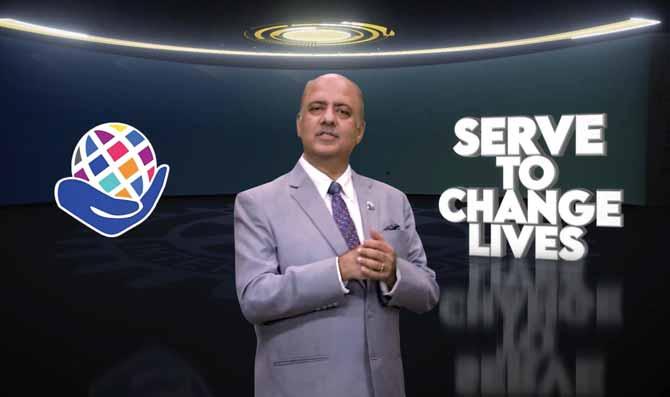
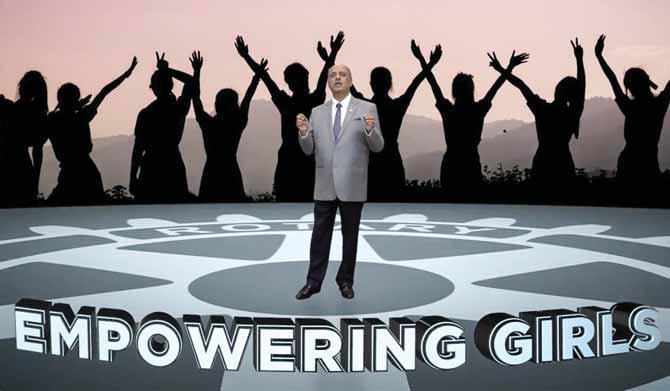

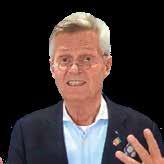



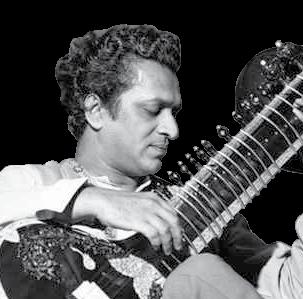
10 Time to upscale our performance
RIPE Shekhar Mehta urges incoming district governors to think big, addressing The Odyssey, the virtual Rotary institute.
14 Let us embrace the digital age
RI President Holger Knaack tells DGEs that Rotarians should make increasing use of technological tools in his convocation address at GETS.
20 Pandemics offer hope too
Trustee chair K R Ravindran explains how TRF responded quickly to help communities during the pandemic.
22 Crucial public healthcare lessons from the Covid pandemic
WHO chief scientist Sowmya Swaminathan highlights the need to invest in public health to prevent and control diseases.
24 Our diversity allows us to be so brilliant & shine brightly
RIPN Jennifer Jones stresses on the mantra of unity, equity and diversity at two virtual meets held by Synergy Alliance and RC Madras.
51 All clubs should get PAN and be KYC compliant
RIDs Bharat Pandya and Kamal Sanghvi urge Rotary clubs in India to comply with GoI’s new rules for the voluntary sector.
64 Ravishankar, sitarist nonpareil
Read about the life and work of the legendary sitarist.
70 Of shikaras and heaven on earth
A nostalgic journey to the all-time favourite TV serial, Gul Gulshan Gulfam, made into a book with the same title.
On the cover: A dance by Mansi Karani and troupe as part of Odyssey, the virtual Rotary institute. Picture by Vivek Advani

As I opened the Jan issue of the magazine, right from the Inside page, down to the LBW column by TCA Srinivasa Raghavan, titled Absence of strong views… one human character that struck me is flexibility.
Rasheeda’s words in the editorial: “If this virus has taught us some lessons and helped us become better human beings...” is my hope too. Let us pray we all learn the right lessons from this pandemic. Happy new year to you and your team at the Chennai office.
Nan Narayenen RC Madurai West D 3000
Nice to read your January editorial. One thing is for sure that this pandemic is a boon for Rotary as we in different parts of the world would not have had a chance of knowing each other and connecting with so many people and knowing them face-to-face. If not personally, but surely virtually, we have seen our counterparts in most parts of the world.
Salute to Rtn Chakravarthi for donating his son’s organs
Strategic planning is a must to achieve success in all areas of life including Rotary, as was nicely said by RI President Holger Knaack. RI director Bharat Pandya has rightly put it by stating “let us build ourselves better so that we can make our clubs
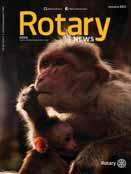
Hope these virtual meets will be part of all major district events, not for free of course, but with a nominal payment and open to Rotarians from not only the respective districts but all around the world.
R Murali, RC Coimbatore West D 3201
The Editor has elaborated upon the post-corona world in a nice manner under the headline What this pandemic has taught us. She has written it with both substance and sensitivity. This pandemic has brought about drastic changes in our lifestyle and daily routine as we spent quality time with our families.
better and the community a better place to live in.”
Rtn Bikkina Chakravarthi has donated the organs of his brain-dead son Srikanth, thus giving a new lease of life to four persons. Hatsoff to this family. It is noteworthy that RC Mysuru is running tailoring and beautician courses for the last 17 years charging a minimum of ` 1,000 per head. So far, 1,500 underprivileged
We have also become more technology savvy. We reached out to our friends and relatives through video calls/WhatsApp and worked from home using internet.
We developed a more inclusive social perspective as we came together to help each other, especially the underprivileged families during tough times.
Above all, the pandemic helped to heal the environment around us. We gained a cleaner environment as we stayed put in our homes and nature got back some of its pristine beauty. We also learnt the importance of preserving our environment.
Raj Kumar Kapoor RC Roopnagar — D 3080
Congrats to Editor Rasheeda for a well-compiled Jan issue. All articles are interesting to read. A season of Hope and Opportunity by RID Dr Bharat Pandya is excellent as it highlights the issues and problems faced by masses across the world during the pandemic.
women in Mysuru have become entrepreneurs. Congrats to the club.
S Muniandi, RC Dindigul Fort — D 3000
The cover photo of the Jan issue was excellent. The photos in the article When pictures speak are lively. Hats-off to Rtn Bikkina Chakravarthi for donating organs of his deceased son Srikanth.
Kudos to RC Bombay Mahakali Heights for their meaningful donations to tribal girls.
Dr Pon Muthaiyan RC Aduthurai — D 2981
Features on Afghanistan, Mohammed Rafi
As soon as the postman delivered the Jan issue, I hurriedly opened it to have a quick glance.
The article on mammography equipment by the editor shows that many hands with one mind can make wonders and consistent efforts lead to big achievements. Another piece on a grief-stricken Rotarian couple is heartrending.
RC Rasipuram donates cows to transform lives of rural women by V Muthukumaran is truly inspiring and also presents a novel project idea. S R Madhu has nicely penned the incomparable qualities of singer Mohammad Rafi and the magic of his voice. Best wishes to the editorial team.
Shraddha V Pai, RC Thane Green City D 3142
The article on Mohammad Rafi by S R Madhu was mesmerising with its beautiful lay-out, lovely anecdotes and pictures that brought back the memories of my college days. A nostalgic reading for me.
Thank you, the writer and the editorial team for giving us such a beautiful new year gift!
Guru Dutt, RC Dombivli East D 3142
The cover, quality of content, print and pictures are superb for which the credit goes to Editor Rasheeda Bhagat and her team.
I explored the pages and wanted to read many articles in detail. And the last page (inside cover) made me to pause with a couple of snippets titled Heart in a bag and Scientists discover new organ in throat . This forced me to go through that column instantly. The features on Afghanistan and Mohammad Rafi, among others, quenched my thirst for reading good
articles. Wish the RNT team a happy new year.
Darshan Singh Baid RC Kharar — D 3080
Thefeature on Afghanistan turns the spotlight on the prevailing socio-economic conditions in that war-ravaged country. Women have borne the brunt of cruelty under the Taliban rule. This brutal regime never gave importance to the education of children. We are looking forward to the second part of this feature on Afghanistan.
R Vasudevan, RC Kumbakonam
Central — D 2981
Chennai flower sellers: Will Rotary come forward?
Thecover story on Chennai’s flower sellers in the Dec issue is really heart touching as it made us realise that in the Covid pandemic many people are still suffering financially as well as mentally.
You have portrayed the real-life situation of these women, but the feature should have come out with steps Rotarians need to take for bringing relief to such people suffering due to the pandemic. So that we can take measures to improve their financial condition in these difficult times.
I feel all will read the article, appreciate it and forget about this
Appreciation from a non-Rotarian Icongratulate you for bringing out Rotary News in an excellent manner.
I received the January issue recently and liked your editorial, the overall content, and especially the article Afghanistan: more questions than answers.
Please include us as a special guest in your mailing list to receive the magazine. Wish you a wonderful 2021 ahead.
Dr Srikanta K Panigrahi director general, Indian Institution of Sustainable Development (IISD)
issue after sometime. It is better to give training to such women in making agarbattis from the flowers and sell them at good rates.
Rotary clubs must take the initiative in training the flower sellers, get them work, finance their vocation and market their produce to support their livelihood. Further, Rotary agarbattis can be marketed which will improve these women’s financial condition and also enhance the public image of Rotary.
Rajesh S Pardeshi RC Ahmednagar Central — D 3132
We welcome your feedback. Write to the Editor: rotarynews@rosaonline.org; rushbhagat@gmail.com. Mail your project details, along with hi-res photos, to rotarynewsmagazine@gmail.com
Messages on your club/district projects, information and links on zoom meetings/ webinar should be sent only by e-mail to the Editor at rushbhagat@gmail.com or rotarynewsmagazine@gmail.com WHATSAPP MESSAGES WILL NOT BE ENTERTAINED.
Click on Rotary News Plus in our website www.rotarynewsonline.org to read about more Rotary projects.

n Rotary, Feb 23 is our anniversary, and February is also the month when we focus on promoting peace. There is a reason for this: Contributing to peace and international understanding has been a high priority for us since our earliest days.
We are often asked: “How can we get involved in peace now?” There are many paths to peace in Rotary. Our youth programmes point us in the direction of Positive Peace, as does the work of intercountry committees and the Rotary Action Group for Peace.
Another path is the Rotarian Peace Projects Incubator (RPPI), an inspirational collaboration among Rotarians, Rotaractors and Rotary Peace Fellows and alumni. Led by Rotarians in Switzerland and Liechtenstein, RPPI has designed 48 global projects that any club can support, either directly or through Rotary Foundation global grants. Nino Lotishvili and Matthew Johnsen, alumni of the Rotary Peace Center at Chulalongkorn University in Bangkok, Thailand, are two of the many volunteers.
During my Rotary peace journey, I have learned how personal resilience helps build inner peace and create sustainable outer peace. This was the inspiration behind the Women Peace Ambassadors for the South Caucasus project, which is based on my field research in Georgia. The RPPI team of Rotarians and peace fellows recognised the incredible potential of women from mixed-ethnicity families who live on borderlands to be role models for peace within and beyond their communities. Through workshops on building inner and outer peace that draw on the power of storytelling, 40 participants will be sharing their stories and
reaching around 400 extended family and community members. These inspiring but marginalised women will reclaim their inner strength as peacebuilders at the grassroots level. In this way, we will take steps toward the sustainable, peaceful society we need so much, not only in our region, but throughout the world. — Nino Lotishvili
I was excited to join the peace incubator project and to further strengthen my ties with Rotary’s peace community by working with past and current peace fellows to develop these proposals. My team wrote five proposals — three in Bangladesh, one in Iraq, and one in Poland — that focus on the arts and on education to generate dialogue across religious divisions and avert the radicalisation of young people. I was inspired by how, despite the pandemic, we came together via technology with a vision to develop, test, and strengthen ideas and to produce workable solutions that clubs across the world can support to advance peace. I am excited to work with Rotary’s peace community to transform these visions into reality. — Matthew Johnsen
Here is further proof that in Rotary, we prefer action to words. This is Rotary at its best. I encourage you to visit rppi.ch to explore the projects and support them.
We have lasted 116 years because of our strong ethics, our passion for Service Above Self, and our unique approach to problem-solving. One of our greatest strengths is how we reach across our communities and across national, ethnic, religious and political divisions to unite people of all backgrounds and to help others. This month, let’s celebrate our history and the many ways that Rotary Opens Opportunities to advance world understanding, goodwill and peace, our ultimate mission.
Holger Knaack President, Rotary International

Nino Lotishvili Founder and CEO, Peace Research Center Tbilisi and Mindful Georgia

Johnsen Professor emeritus and founding co-director, Center for Social Innovation, Worcester State University, Massachusetts

Even as RI President Holger Knaack advised the incoming district governors at the zone institute aptly titled ‘The Odyssey’ to embrace the digital era, the organisers managed to pull off a remarkably impressive virtual institute. Rotary India’s trio comprising RI director Kamal Sanghvi, RIDE Mahesh Kotbagi (who chaired GETS) and institute chair PDG Sanjay Khemka harnessed solid hard work, creativity and some slick and creative technology to give the feel of a physical event. You logged in, took a virtual walk to the central auditorium and other areas. The whole experience left you marvelling at the constant innovation that technology enables.
As I traversed the galaxy, session after session, Sanghvi’s statement that the institute team had tried hard to get the best women speakers too, in consonance with Rotary’s goal to not only increase women’s membership but also leadership, rang true. Some of the women speakers really dazzled, giving us hard truths about the pandemic from both a professional and a gender perspective. WHO chief scientist Sowmya Swaminathan, in her signature, no-fuss fashion, explained to the delegates how and why some of the most developed countries had recorded high Covid infections and mortality rates. This was because of failure to invest adequately in a robust public healthcare system so essential to deal effectively with epidemics and pandemics. Her message was clear — such investments do not give tangible results but are crucial in prevention and control of a plethora of diseases.
Both Sowmya and UNICEF India head, Yasmin Ali Haque, tugged at the heartstrings of Rotary leaders attending the institute with shocking figures on
how this pandemic has been much harsher on girls and women. Sowmya pointed out that both domestic violence and trafficking of women have insidiously increased in the Covid-19 era, and urged Rotarians and world leaders to also deal with the corona aftermath with “compassion”. Haque painted a grim scenario of how severely the education of girls has been affected. She said UNESCO estimates that globally 11 million girls might not return to school this year due to the unprecedented disruption in schooling during the pandemic. Even before the pandemic, “an estimated 30 million children in India were out of schools; 40 per cent being adolescent girls.” Also, in India girls get 4.4 years in school compared to seven years for boys. “This indicates the threat to decades of work in gender equality and also puts girls at the risk of adolescent pregnancy, early forced marriage and violence. We, of course, have the dubious distinction of having one of the largest shares of child brides in the world, and this is predicted to rise due to the pandemic. In June and July 2020 alone distress calls to Childline India related to early marriage of girls went up 17 per cent. You wanted to cry when she said: “For many girls, school is more than a key to a better future. It is a lifeline, albeit a fragile one.” Ponder over this….
As also the inequity in accessing digital learning tools by girls compared to boys, and how disastrous this will be in an era in which more and more learning will shift to online platforms in the future.
Even though fragile, let us provide the lifeline of education to our girls, and then handhold them to safer shores and a future filled with hope.
Rasheeda Bhagat
RI Dist 2981
RI Dist 2982
RI Dist 3000
RI Dist 3011
RI Dist 3012
RI Dist 3020
RI Dist 3030
RI Dist 3040
RI Dist 3053
RI Dist 3054
RI Dist 3060
RI Dist 3070
RI Dist 3080
RI Dist 3090
RI Dist 3100
RI Dist 3110
RI Dist 3120
RI Dist 3131
RI Dist 3132
RI Dist 3141
RI Dist 3142
RI Dist 3150
DG R Balaji Babu
DG K S Venkatesan
DG A L Chokkalingam
DG Sanjiv Rai Mehra
DG Alok Gupta
DG Muttavarapu Satish Babu
DG Shabbir Shakir
DG Gajendra Singh Narang
DG Harish Kumar Gaur
DG Rajesh Agarwal
DG Prashant Harivallabh Jani
DG CA Davinder Singh
DG Ramesh Bajaj
DG Vijay Arora
DG Manish Sharda
DG Dinesh Chandra Shukla
DG Karunesh Kumar Srivastava
DG Rashmi Vinay Kulkarni
DG Harish Motwani
DG Sunnil Mehra
DG Dr Sandeep Kadam
DG Nalla Venkata Hanmanth Reddy
RI Dist 3160 DG B Chinnapa Reddy
RI Dist 3170 DG Sangram Vishnu Patil
RI Dist 3181 DG M Ranganath Bhat
RI Dist 3182 DG B Rajarama Bhat
RI Dist 3190 DG B L Nagendra Prasad
RI Dist 3201 DG Jose Chacko Madhavassery
RI Dist 3202 DG Dr Hari Krishnan Nambiar
RI Dist 3211 DG Dr Thomas Vavanikunnel
RI Dist 3212 DG P N B Murugadoss
RI Dist 3231 DG K Pandian
RI Dist 3232
RI Dist 3240
RI Dist 3250
RI Dist 3261
RI Dist 3262
DG S Muthupalaniappan
DG Subhasish Chatterjee
DG Rajan Gandotra
DG Fakir Charan Mohanty
DG Saumya Rajan Mishra
RI Dist 3291 DG Sudip Mukherjee
Printed by P T Prabhakar at Rasi Graphics Pvt Ltd, 40, Peters Road, Royapettah, Chennai - 600 014, India, and published by P T Prabhakar on behalf of Rotary News Trust from Dugar Towers, 3rd Flr, 34, Marshalls Road, Egmore, Chennai 600 008. Editor: Rasheeda Bhagat.
The views expressed by contributors are not necessarily those of the Editor or Trustees of Rotary News Trust (RNT) or Rotary International (RI). No liability can be accepted for any loss arising from editorial or advertisement content. Contributions – original content – are welcome but the Editor reserves the right to edit for clarity or length. Content can be reproduced with permissionand attributed to RNT.

The miracle is not to fly in the air, or to walk on water The real miracle is to walk well on the Earth.
gives us the opportunity to make our earthly walk special. And one of the best ways it does that is through our work in the field of peace, goodwill and world understanding. Peace starts at home, in every corner of our house and everything we say and do. All of us also should know that peace in our own lives, much like attitude, is a choice. Peace is not just the absence of war, it is also about feeling safe, having enough food to feed your family, an opportunity to get education and thrive without being handicapped by avoidable diseases. I believe Rotary is all about hope. Hope for a brighter future and better world for future generations. In a world filled with conflict, war, terrorism and darkness Rotary offers a ray of hope by working for peace and goodwill. Our work for peace doesn’t happen only at conferences and seminars. It happens through personal relationships, service, meeting basic human needs and working with each other to resolve conflicts. It happens through reaching across borders and continents and helping develop conditions that allow peace to flourish.
Global conflict has created a huge crisis with an estimated 68.5 million refugees. The economic impact of violence on the global economy in 2019 was $14.5 trillion in purchasing power parity (PPP) terms. This figure is equivalent to 10.6 per cent of the world’s economic activity (gross world product) or $1,909 per person. According to the Global Peace Index, 81 countries became more peaceful in 2019 and 80 countries less so. Peacefulness has declined year after year for nine of the last 12 years. This is something we in Rotary can and should do something about. Rotary’s Peace Scholars programme is aimed at tackling issues of global conflict.
Peace is a state of harmony characterised by absence of violence, freedom from fear and a good quality of life. Service is an activity performed for the benefit of others. Individually they are dissimilar, but look closely, and they are interlinked and intertwined. When basic needs — food, water, shelter, health — are not met peace is difficult to achieve. When people are hungry, homeless there is a tendency to fight and grab, with resultant conflict. Three Bs — Bread, Bed and Basic education — are needed for positive peace. Rotary is working for positive peace by meeting the needs of the community. Rotary service is peace in action.
Significantly, Prof Muhammad Yunus got a Nobel prize not for Economics, which was widely expected, but Peace, because he had enhanced the livelihood of poor women and lifted them out of poverty.
Tolerance, integrity and service are the three cornerstones of positive peace. Rotary’s peace efforts are the example of the power of one — one Rotarian, one club, one district multiplied many times. Make most of the opportunity. Enjoy Rotary, enjoy yourself.

Dr Bharat Pandya RI Director, 2019–21
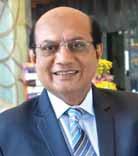
Dear Rotary leaders, Conflict and violence have displaced millions of people around the world over the years. We Rotarians should refuse to accept conflict as a way of life, as our community service projects strive to provide training that fosters understanding and provides communities with skills to resolve such conflicts.
Rotary promotes peace and reduces conflicts and tensions around the world not only through its service projects, but also peace fellowships. Both our members and scholars are constantly and continuously taking action to address the underlying causes of conflict, including poverty, inequality, ethnic tension, lack of access to education and unequal distribution of resources.
For me, peace is giving food to the hungry, limbs to the handicapped, sight to the blind, home to the homeless, water to the thirsty and opportunity to learn for the illiterate. Just imagine how much of all this we Rotarians did across the world as an unprecedented Covid-19 pandemic devastated the world. As countries locked down for long periods and economic activity was severely curtailed, people struggled with their livelihoods. Businesses were impacted and thousands and thousands lost their jobs. The disadvantaged sections of our communities, infected by this virus, struggled to get adequate treatment. Just look at the way Rotarians across the world came out, bravely and passionately, to feed the hungry and the homeless, and stood shoulder to shoulder with their governments and healthcare providers by providing masks, sanitisers and PPE kits in huge numbers, bolstering hospital equipment, setting up ventilators and doing all that it took to bring comfort to the sick and the hungry.
While on the one hand the Rotary Peace Centres programme creates peace scholars who work for conflict resolution and promote peace, in the Covid era, all of us became promotors of world peace through our passion to do good.
Let us all pledge to continue our efforts to bring succour to those who are suffering the aftermath of this pandemic, help our governments vaccinate our people and be a beacon of hope and peace during these difficult times.

Kamal Sanghvi RI Director, 2019–21
Board of Permanent Trustees & Executive Committee
PRIP Rajendra K Saboo RI Dist 3080
PRIP Kalyan Banerjee RI Dist 3060
RIPE Shekhar Mehta RI Dist 3291
PRID Panduranga Setty RI Dist 3190
PRID Sushil Gupta RI Dist 3011
PRID Ashok Mahajan RI Dist 3141
PRID P T Prabhakar RI Dist 3232
PRID Dr Manoj D Desai RI Dist 3060
PRID C Basker RI Dist 3000
TRF Trustee Gulam A Vahanvaty RI Dist 3141
RID Dr Bharat Pandya RI Dist 3141
RID Kamal Sanghvi RI Dist 3250
RIDE A S Venkatesh RI Dist 3232
RIDE Dr Mahesh Kotbagi RI Dist 3131
Executive Committee Members (2020–21)
DG Sanjiv Rai Mehra RI Dist 3011
Chair – Governors Council
DG Sudip Mukherjee RI Dist 3291
Secretary – Governors Council
DG Sangram Vishnu Patil RI Dist 3170
Secretary – Executive Committee
DG Prashant Harivallabh Jani RI Dist 3060
Treasurer – Executive Committee
DG S Muthupalaniappan RI Dist 3232
Member – Advisory Committee
ROTARY NEWS / ROTARY SAMACHAR Editor Rasheeda Bhagat Senior Assistant Editor Jaishree Padmanabhan
ROTARY NEWS TRUST 3rd Floor, Dugar Towers, 34 Marshalls Road, Egmore Chennai 600 008, India. Phone : 044 42145666
e-mail: rotarynews@rosaonline.org Website: www.rotarynewsonline.org
Now share articles from rotarynewsonline.org on WhatsApp.

Rasheeda Bhagat
Imiss shaking hands and exchanging warm hugs in picturesque Kochi, but in this new normal, this outstanding institute has been organised virtually. The human spirit has taken up the challenge of the Covid pandemic with resilience, grit, patience, discipline and above all, hope, which is a
pl i ne an d a b ove a ll , h ope, w hi c h i s a powe rful t hi ng It i ns pi res us to do th e im po ss ib le a nd h el ps p u s ca rr r y on d u ri ng diffi cu lt tim es,” s ai a d RI
Pr es id en t El E ec e t Sh S ek h ha r
Me M h ta, a d dd re ss in i n g th e i n au gu ra l se ssi on o f th e RI I R z on e in n st t s it i ut t e e.
He H told d p partrticcipa p nts at a the e virttu l al

institute titled ‘The Odyssey’ that this hope was now turning into reality with several vaccines on the horizon, “created in record time against the biggest disaster that we’ve seen in our lifetime.” Urging Rotarians to celebrate the spirit of hope and humanity, Mehta said hope allows people to “survive, adapt and excel despite adversities taking such a horrible toll during this . For Rashi and me, it has been a year best forgotten; between us we lost a dear father and a mother. We lost our dear Binotadi (wife of PRIP Kalyan Banerjee) and our special friend Yash (PRID Y P Das).”
International Assembly — had to go virtual “denying thousands of Rotarians the joy of fellowship, networking and learning, and yet we look forward to a healthier world.”
to “survive, and excel desp adversities a horrible t this annus horribilis. For Ra and me, it has been a year a besest t forg tenn; beetweeen us we lost t a d fathher e a d nd a m t othe h r. We e l ouur r deear a Binotadi i (wwiffe PR R IP P K al ya n Ba a n ne r j e an d ou r sp ec ia l f fr ie Ya Yash h (PRRID I Y P Daas) s)


Mehta announced that Rotarians “will do our best to help governments in the vaccination process.”
T Two of o RII’s b bigg g events — Conveent n i ioon a
Two of RI’s biggest events — Convention and
In India, along with PRIP Rajendra Saboo, he and other Rotary leaders had met Union Health Minister Harshvardhan and the Niti Aayog leaders. Work had started at the grassroots in UP, Karnataka and other places, “where Rotary had been invited by these states as people with polio vaccination experience.”
He added that as Rotarians, “there is a lot that we can do to stop Covid. We can help in the distribution of vaccines, provide training and certification to vaccinators. We can provide our hospitals, blood banks, schools etc as vaccination centres and also help in social mobilisation, advocacy against vaccine resistance, etc.”
Mehta added: “Polio gave us a silver lining last year and with Africa declared polio-free we are this close to ending polio. The last leg of the marathon is most crucial and painful but the runner’s eyes are on the finishing line and not on the pain. Let us put our best foot forward and contribute to TRF for polio because our contributions
Rotarians can help in vaccine distribution, provide training to blood banks, schools etc as vaccination centres and do advocacy against vaccine resistance.
the PM Cares Fund, “you have done immense work at the grassroots level, providing masks, sanitisers, medical equipment, food, etc, taking the combined worth of both to “nearly a value of $30 million in India including the contribution to the PM Cares Fund.
And this did not impact our contribution to TRF. We reached our goal.”
While Rotary in Nepal and Pakistan was also adopting these programmes, “the GoI is now working with African nations and wants to help them with this and other additional content for learning.”
Tare multiplied by TRF and the Gates Foundation.”
TRIPE Shekhar Mehta connected and Like alll of you, I too have zoomed across m meetings, sometimes panninng g severaal l c continents, in just a singlle e day O Onne e p particular day, I was in n Affriccaa, Sou o th A America US, Europe e annd South th Asia.”

he challenge of the pandemic had also made “us flexible nimble, more connected and nearly omnipresent. Like cal world. “Our speed to hold meet-
H e a dd e d t h a t R RC D e l h hi S ou th h W West, RID 3011, has s been orggaannisising for the 20 years a siit-aand-draw w coompetition Last year r thhey had 6,0000 0 parrticipants; this yeaar at th t e virtual l e evenent which he particippated d in, oveer r 12,000 0 children from 20 countri r es paartiiccipate t d. The lessons learnt t from m th t e pa panndeemmiic c will now allow Rottarians to o geet t t the best from both the e virtual and nd phyysical world. “Our sppeeeed d to hoold d me m ettings and take deciissions has inncreaseed considerably,” he said. Thhe e RI Boaoard d now meets every alternate m moontth h annd d the Trustees are e “a a shad a e beett t er r Th They y meet every monntth h and n quiuick k deccis i ioons are now the outc t om o e foollllow o in ing the increasing abilitty y to addappt. t ”
Thanking Rottar a i iaanns for the h i ir geennerosity during the e pannddemic, he sa s id that apart from m a hu huge e conntr t ibbuutioion n to o
he incoming RI president said last year the service projects done in our zones in all the Rotary’s areas of focus were outstanding. Whether it was tree plantation, solar projects, blood banks, dialysis centres, heart surgeries for children, or building rural toilets, WinS, etc, great work had been done. “I feel particularly proud of the work done by RILM. The nearly 1,500 hours of audio-visual content that we provided to the GoI is of outstanding quality according to the government itself. And the government’s numbers say that along with other content, it has got 400 million hits.”
Saying that this pandemic “has given us the time and opportunity to sharpen our axe”, Mehta urged Rotarians to take up projects of much bigger size and far-reaching impact. “I take great pride in the service activities, growth and impact that Rotary is making in South Asia. Next I hope you will take up the challenge of ‘each one bring one’ in the next 18 months.”
Along with increasing membership, there was also need to set up more flexible clubs… satellite clubs, cause-based clubs etc. “The opportunities are great. In the past we have expanded our reach, now is the time to upscale our performance.”
He added: “Let our giving to TRF also go up like never before. Currently Trustee Chair K R Ravindran is from our zone, and from July 1, the RI president will be from our zone. We’ve



always excelled in TRF giving during such times. Let’s do it once more with our focus also on annual and polio giving.”
Concluding on an optimistic note, he said that hope was the elixir of life. “It leads to innovation, discoveries and excellence. We have hope of a totally literate South Asia, hope of working with our governments to bring water, sanitation and empowerment to our communities, leading to the hope of peace in our world.”
In his opening speech, institute convener and RI director Kamal Sanghvi said for all the pain it had brought, the corona pandemic had also done some good. “We have started cleaning our houses and surroundings on a regular basis, and nature is healing and thanks to our minimised movement, has got a well-deserved break. Flamingoes have painted Mumbai pink and the Himalayas can now be seen from Jalandhar. Delhi has a clear blue sky. Family relationships have strengthened as this pandemic
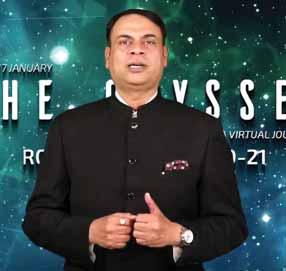
has impelled us to spend time with our families.”
Technology was an integral part of this new reality and had helped improve educational practices. Digitalisation of education was already under way “but this crisis has accelerated the transformation. And RILM has initiated perhaps the world’s largest online learning programme, along with the NCERT and the HRD ministry, benefitting nearly 15 crore children across in India.”
environmentalists, lawyers, actors, poets, entertainers, and bankers will speak to us, to make this an institute of knowledge.”
Of course, he added, “there is no greater joy than finishing the race and the last hurdle for ending polio from the entire world still remains, but we will remove it and finish that race.”
Covid has done some good too; we clean our houses and surroundings on a regular basis, and nature is healing and got a well-deserved break. Flamingoes have painted Mumbai pink, the Himalayas can be seen from Jalandhar and Delhi has a clear blue sky.
RI Director Kamal Sanghvi
RILM had also launched a pilot skilling programmes titled Saksham Bharat to skill young adults with guaranteed employment. He announced that 51 young adults had graduated that very day with job placement, and “the next 100 will graduate shortly; during this year we want to skill 5,000 people under this programme.”
Sanghvi said virtual platforms had increased both meetings and connections. “The needs in the world are greater than ever before. It’s like climbing a steep mountain yet the mountain has to be climbed.” The institute team had traversed the unknown and created The Odyssey, bringing as speakers some of the world’s greatest “achievers, businessmen, thinkers, doers, speakers and deliberators; 14 CEOs, educators,
In his welcome address, institute chair PDG Sanjay Khemka said that while it was a heartbreaking and tough call to move the institute from the “lush backwaters of Kerala to a virtual platform, we took that call and did it.”
As he pointed out, optimum use of the best technology had been made to give the participants a feel of entering an actual auditorium to listen to the speakers, and the visual effects were stunning. Khemka added that the delegates would get a flavour of Kerala through a gift hamper that was put together with products made with natural products by a group of disadvantaged women who had formed an organisation called Wild Ideas. The institute also had virtual stalls and he urged the participants to visit them.
Designed by N Krishnamurthy

Giving is more than an activity. It is a way of life and a beacon in the search for hope in troubled times. There is great turmoil today, but these are not unusual times, not in the span of human history. The wisdom of the ages is especially important to help us set our path and purpose.
Such wisdom comes from the 12th-century philosopher known as Maimonides. Born in Córdoba, Spain, he and his family went into exile in Morocco to escape religious persecution. As a young man, he mastered Aristotle, astronomy, and later medicine. After moving to Cairo, Maimonides became known as the city’s greatest rabbi, producing tomes of commentary on the Torah, and he lived out his final days as a renowned doctor.
But his greatest gift to humanity captured his thoughts about giving itself. His Eight Levels of Charity is a masterpiece that teaches us about what giving means and what motivates us to do it.
The bottom rung of Maimonides’ ladder is giving out of pity or grudgingly. The next step up is giving less than one should, but doing so cheerfully. Climb up to the fifth rung and you are giving before being asked. Further up the ladder is giving in a way that the receiver does not know who the giver is. The eighth and highest level of charity is to anticipate distress and giving to avoid or prevent it.
When we immunise children against polio, we are anticipating potential illness. We do so with other efforts, such as Rotary projects that reduce the incidence of malaria or cervical cancer.
When we teach someone a profession that enables them to earn a living, we apply the eighth step. From microfinance to education, The Rotary Foundation helps us give the gift of self-reliance.
All of this good work awaits us, as does the work of supporting newborns, cleaning water sources, recovering from the Covid-19 pandemic, and countless other efforts we lead.
I am proud to say that many Rotary members climb to the top of Maimonides’ ladder. Many of them do so anonymously. Whoever they are and for whatever reason they share their gifts with the Foundation, I thank them.
As an organisation, Rotary climbs that ladder as well. Every one of your donations helps us reach higher levels. As we climb this ladder as one, we gain a wider perspective. We see all those who need to be uplifted as well as the countless opportunities we have to help them in Rotary. And as we do so, we find our own meaning and purpose.
Dear Rotary members,

How difficult is it for leaders to find the right words to motivate people in difficult times, which offer little by way of hope? Despite vaccines on the horizon, we are still grappling with the pandemic.
It’s clear that we can no longer live and work the way we always have; we need to find a new normal. Most of us have regimented lifestyles. We wake up every morning, follow set routines and keep company with the same set of people. Whilst routine may be a source of comfort, it dulls our senses. We also need stimulation — a freshness that vitalises a humdrum existence. This is what Rotary does. It transforms us by giving us opportunities to be effective leaders and a platform to make a difference and do good in the world. As leaders, we have to motivate all Rotarians to contribute to TRF, best done by telling a story.
A young landlord threatens his aged tenant with eviction if rent is not paid. The tenant, a shop owner, explains times are difficult, there is no business and implores him to be considerate but the landlord gruffly refuses. That evening the landlord goes to his sister’s for dinner, praises the spread only to find that she has lost her job. The dinner on the table is thanks to a kindly gesture of her grocery store owner. The brother asks to meet her benefactor, who has been invited too. You guessed right. A man who did not have enough money to pay his own rent, provided goods on credit to a customer facing difficult circumstances. The sheepish landlord waived the rent. There is so much truth in the saying “As you give, so shall you receive.”
What better way to assist people in times of uncertainty than a simple contribution to TRF, which is used to do good in the world. Stay safe and stay well!

K R Ravindran Foundation Trustee Chair
Gulam A Vahanvaty Trustee, The Rotary Foundation

The Covid pandemic, while bringing so much suffering to the entire globe, has also enabled Rotary to open opportunities in many different ways, such as this institute and the virtual meetings we hold. These are so important as they bring leaders together to brainstorm on how to take on the challenges ahead. We are now in a time of rapid change and we have to keep working together to ensure Rotary comes out of this difficult time in a much stronger position,” said RI President Holger Knaack, while delivering the convocation address at
the convocation address at t h e GETS event f or RI zones 4, 5, 6 and 7.
Striking a pensive note , he sa id , “Rotary w as f oun d e d in a world that does n’ t e x ist any l onger, i t i s a d iff erent wor ld now,
Rasheeda Bhagat
which moves faster and is harder to comprehend. And it is filled with crises to manage. And yet it gives us new opportunities.”
stronger, more adaptable and more aligned to our world as it is today.”
Calling upon the incoming governors to embrace the challenges the post-Covid world is going to throw up, Knaack said that crucial values of Rotary, such as fellowship, integrity, leadership, service and diversity “will remain constant. But Rotary has to change and will change and even if some fellow Rotarians complain that it doesn’t feel like the old Rotary, we will change.”
connections.
He said even before this crisis, people were meeting and keeping connected to different friends in different ways. “Social media and online connections were already there but they have now become more important. We are all now used to working virtually. Most important, the younger generation that has grown up in this world, has a stronger desire for service and connections.”
But they didn’t want to wait for their time to lead. “They want to play meaningful roles today. And if Rotary cannot provide them a platform, they will form their own types o f co nn ect i o n s a n d fin d opportunities. The world will not slow down for us, let us capture this moment to grow Rotary, ma k e i t
RI President Holger Knaack
Congratulating the DGEs for getting the unique opportunity to lead their districts and urging them to make the most of it, he said: “it is up to all of us to remake Rotary for these new times, and to wholeheartedly embrace the ideals and commitments of younger people eager to find an outlet for their idealism. We must become an organisation that embraces the digital age, and make it a part of all that we do. It is important that we create a new Rotary for the new age. Rotary is not just a club that you join, it is an invitation for endless opportunities in both big and historic projects such as ending polio as well as small community projects at the club level.”
districts and them to most of it, he said: “it up to for these new to young eager to find an outlet for thei We must an organi embraces the and part of all that we do. It is imp for th a club tha it is an invitation for endles nities in both and histor such as as we at the c
Ideas for change forth a bunch of ide he said ways be creatin different club models. You
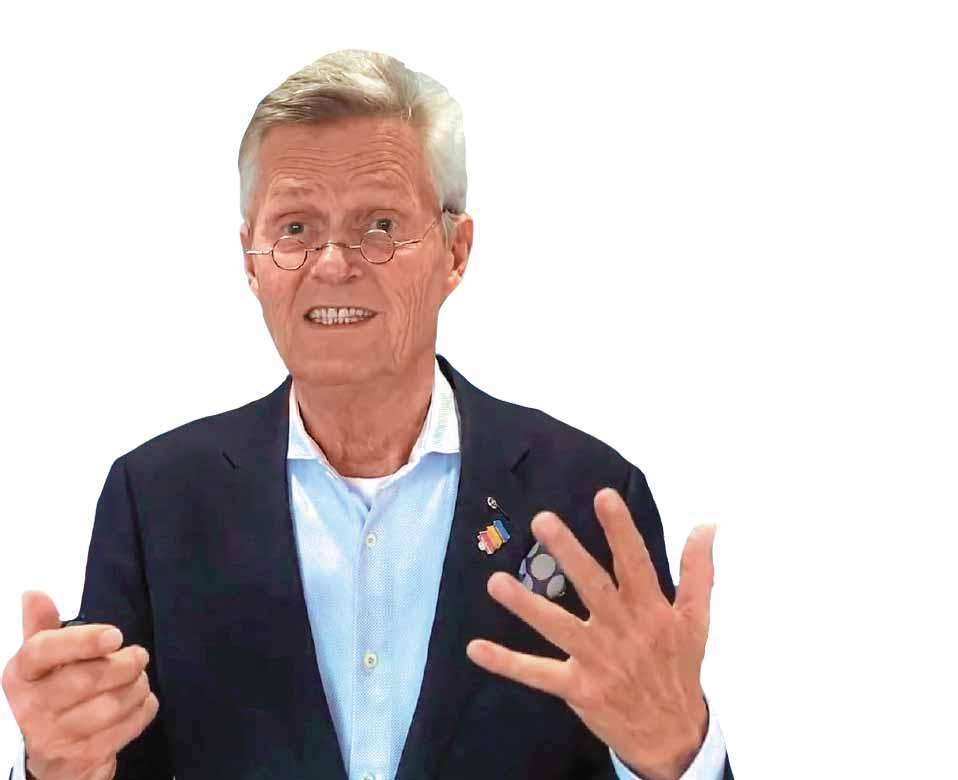
Putting forth a bunch of ideas on how Rotary would change, he said one of the ways would be “by creating new and different club models. Young people can be the architects of these new clubs. We have to be open to new approaches. Some new clubs can be formed around a Rotary area of focus. Or maybe each district could have a club of its alumni. Or new clubs could be associated
We have to open to new a new form a Rotary area of focus. Or m district could a club of O r ne w a
or affiliated with corporates or some organisations. The possibilities and opportunities are limitless. I am challenging Rotaractors, young Rotarians and DGEs to become architects of this change. I would like them to unleash this creativity and seek new ways to invite new Rotarians to clubs in a way that suits their interests and needs.”
Also, underlining the need to embrace diversity, the RI president said an “international approach to diversity” was very essential and district leaders would have to ensure that every club “embraces diversity in ways that are meaningful for members and cultures. The key part of that is the number of women in Rotary everywhere. I am very proud that Jennifer Jones has been elected as RIPN, and in President Shekhar’s term, nine positions on the RI Board will be held by women. This is great progress and we need to see this across our clubs.”
It is important to ensure that Rotary makes progress along with more women members. “Let us make a concerted effort to reach out to people who feel left out and find ways to make them feel a part of the Rotary family.” In building leadership within the organisation people should be selected for leadership positions at every level based on their talent and inclination to lead, “regardless of their background. We should not forget that ours is a wonderful organisation that

has done so much to bring people together from all parts of the globe. Our vision statement is for a world where people unite and take action to bring lasting change in our communities and ourselves,” he added.
Knaack also urged every Rotary club to set up its plan and vision. “I would like every Rotary club to have a strategic meeting at least once a year, and ask where its members want to be in five years and define what value they bring to their members.”
Rotarians know what makes Rotary so unique but people in the communities need to know the value of Rotary and the kind of opportunities members who join Rotary get. This was a challenge all Rotarians needed to take up.
great opportunity before you to make a difference in your district and communities. As RI President Elect Shekhar Mehta advised you, go where the eagles dare, walk your talk. Rotary gives each of us the opportunity to live our dreams, opportunity to think big and make a difference to the world by doing good.”
Urging them to make the most of the one valuable year given to them, Sanghvi said, “You are the chosen ones from your districts and the community, you are future leaders of not only Rotary but your community and the onus lies on your shoulders that the confidence invested in you is justified. Take the leadership within you to a higher platform. Evolve, grow and make sure you justify the confidence placed in you.”
reach out to people who feel left
Holger Knaack RI President
RI director Kamal Sanghvi thanked GETS and GNTS chair Mahesh Kotbagi and said he had chosen him to lead the training seminars “well before he became RIDE! I thank him for the fantastic job he has done in organising this training programme so thoroughly and meticulously.”
Addressing the incoming governors, he said, “Each of you have got a
The governors, who had all turned up for the virtual GETS, along with their spouses in their traditional finery, were all given graduation certificates online by President Knaack.
Addressing the graduates, RIDE Kotbagi asked them to make the best of the opportunity they had as governors elect, as this one year would not return.

The governors-elect and governors-nominee training seminars (GETS and GNTS) formed a prelude to the Rotary zone institute which went virtual this year. The training sessions were breakout sessions on the zoom platform and were named after zodiac signs. GETS, GNTS and Partners’ sessions were followed by an hour of entertainment during Jan 7–10. GETS and GNTS chair RIDE Mahesh Kotbagi and his team had pulled out all stops to make these training events memorable and effective for the incoming leaders.
Shekhar and his movers
The DGEs were told by incoming RI president Shekhar Mehta: “Remember these are tough times; dedicate this year to the people around you. But always put family first. You are leading a part of a 115-year-old organisation, which has a legacy of eradicating polio and transforming lives of millions of people across the world. You’re from a country which is a Kohinoor in Rotary’s crown. So, your dreams and plans must be special.” They will be district governors during Mehta’s year as RI president.
He referred to the lines from Dan Palotta’s book Uncharitable which he has been reading recently. “It says between a person heading an NGO and a CEO of a corporate, the NGO head is paid less. But NGOs handle most of the community’s issues while a corporate is engaged in enhancing its profits. Being an NGO leader may be a thankless job but it is a soul-satisfying endeavour.”
Urging the incoming leaders to dream big, he recalled how as a newbie Rotarian, he had in all innocence said that his goal was “to become a good governor” in reply to his mentor’s question. “He told me, Shekhar, that is not a
goal. Your goal should be definite and purposeful. So, I went back and rewrote my goals and have been fairly successful till date.”
He counseled the DGEs and DGNs to seek the support of their district teams. “Involve them to do the job and share the credit. My mentor always said that a DG’s job is to lubricate the egos of club presidents. And that holds true. As a leader, you must delegate work. If you think you can do everything, you will be a failure.”
Concluding, the incoming RI president warned with a smile: “Your leader has a favourite slogan. I won’t sleep nor will I let you sleep until a job is done. For this one year, let us live for others. Be an eagle, soar so high that nobody dares to be where eagles dare. At the end of your year, you will look back and say, ‘those were the most beautiful 365 days of my life’.”
Addressing the partners, he said, “You too have to get involved in serving Rotary and with your push,
It is not for medals that we are telling our stories, but to ignite the fire of service in others.
Kamal Sanghvi RI Director


your spouse will be a really good governor.”
Enhancing public image Institute convener RID Kamal Sanghvi urged the DGEs and DGNs to “set your standards high. You must first win your own self before you can win the confidence of your team. Be passionate about your service activities and greedy for membership and TRF contributions. Create your own benchmarks and tread surefootedly.” He stressed the importance of public image, saying that Rotarians should popularise their service activities and Rotary experiences on social media. “It is not for medals that we are telling our stories, but to ignite the fire of service in others. Instead of publishing the news after doing an eye camp, do it before the camp. Write there, ‘All those who want to join to help us, are welcome.’ People will join hands with you. We need to have a positive image in the community to attract new members and keep the existing ones. Both these are extremely important for Rotary to survive.”
Institute chair Sanjay Khemka welcomed the incoming district leaders saying that they have to reach the
Your leader has a favourite slogan. I won’t sleep nor will I let you sleep until a job is done.
Shekhar Mehta RI President-elect
horizons with all that they learn from this training seminar. RIDE Kotbagi observed that this year will be a challenging one and with travel restrictions it will be a humongous task for the district leaders. He christened the DGEs ‘Shekhar and his movers’. “Although we could not meet at Kochi as planned much earlier, I guarantee that you will cherish for life what you learn on this virtual platform,” he promised.
Support the Foundation
RI Director Bharat Pandya, referring to the enormous support provided by TRF, said, “during these gloomy nine months, TRF had shone as a beacon of hope. Despite this darkness and despair, Rotarians remained committed to TRF, in programme participation and supported the Foundation by raising funds. Individually we may not be able to do much for international peace, but the Foundation helps us contribute our collective energy. Its success tomorrow requires our support today.”
He urged the district leaders to promote giving to the Annual and Polio Funds. The demand for GGs has
brought sharp focus to Annual Funds. “It is important to grow this fund otherwise our GGs will die a slow death. Encourage all Rotarians to contribute whatever they can to the Foundation,” he said.
Membership growth
RIDE A S Venkatesh and PDG
Ravi Vadlamani laid stress on the importance of membership development while addressing the incoming leaders. “All along we have been satisfied with, what I call, the ‘delta changes’ — three or five per cent growth from the previous year. It is time to think out of the box now. The order of the day is disruption — not doing the same thing but something outrageously different,” said Venkatesh, leaving a few questions for the incoming leaders to ponder over to make a quantum jump in membership.
“Start with the population density of your region. You could say, ‘My district has a population of 1.5 crore. Let me see if I can bring 10,000 members.’ Let us not be in
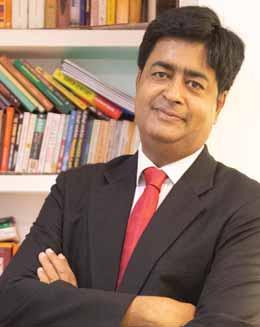
RIDEKotbagi’s wife Dr Amita as programme chair and Sonal Sanghvi as programme convener brought together an interesting partners’ sessions for the spouses on all four days.
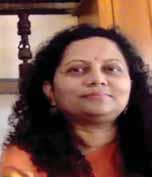
A virtual icebreaking session had the spouses warming up as they shared their interests and talked about their region’s specialties. Rashi Mehta impressed upon them to participate actively in the spouses’ programmes during their leadership year. “Your support will help the governors make a lasting impact in your district,” she said.
Referring to the virtual mode, Vinita, wife of RIDE Venkatesh said, “This has given us a new skill set. It is a testimony of our ability to learn when it is much needed.”
“You are the cheer leaders. Keep encouraging your partners and don’t be shy to share ideas with them. Who knows, it could be a brilliant idea for your district,” said Dr Madhavi Pandya.
the comfort zone of 5 or 10 per cent growth which has been the norm all these years. Our potential lies in our ability and has got nothing to do with what our predecessors have done in the past,” he reiterated. His next suggestion was to consider the demographic composition of the districts. “See if it is reflected in your membership. Single vocation Rotary clubs are also possible now. You can consider a body of doctors or advocates to form clubs,” he said.
On growing clubs, he suggested they study the pattern of growth and how it was propelled. “You might notice that only 20 per cent of members would have brought in a new member each. Take to social media and promote membership saying ‘I have brought in a new member, have you?’”
Above all, he stressed on wearing the Rotary pin outside Rotary meetings. “You will get a chance to explain about Rotary to an inquisitive total stranger and who knows, he may get interested to join your club,” he added.
PDG Ravi Vadlamani recommended formation of separate committees for increasing and retaining members at district levels and recognise Rotarians for introducing new members. “Start Rotary clubs in gated communities and members can meet at their club houses. Such clubs will be sure hits as they also enhance better bonding in the neighbour-
hood,” he said. People sharing similar interests can form clubs. “You can have clubs for cricket, yoga, etc. With Rotary’s enhanced flexibility, the choices are many,” he said.
TRF and Polio
TRF Trustee Geeta Manek from Kenya urged the incoming leaders to not lose focus on polio immunisation for “we have worked very hard to come this far and the day is not far off when we can truly celebrate the milestone moment. But until then there is no room for complacency.” Referring to WHO’s recent polio-free certification for Africa, Geeta said that when India was declared ‘polio-free’ it was an inspiration for Africa to follow. “It has given us renewed energy to eliminate polio from Pakistan and Afghanistan so that the entire world is declared polio-free.” She urged the incoming leaders to give at least 20 per cent of their DDF to Polio Fund.
TRF Trustee Gulam Vahanvaty stressed on maintaining an effective communication with the club presidents and the district team. “Whether it is a global grant or a club project do not do a service project just because you want to do
It is important to grow our Annual Fund; otherwise our GGs will die a slow death.
Bharat Pandya RI Director

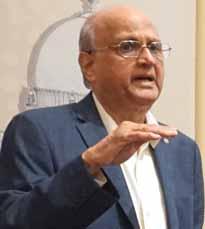
TRF Trustee Gulam Vahanvaty
it. Do a needs assessment and proceed. Seek help from your district Foundation committee and technical cadres,” he said.
PRID Manoj Desai, chair, TRF’s technical cadre, shed light on the evaluation of global grants projects by the Foundation. There
Doing good with TRF help
Our potential lies in our ability and has got nothing to do with what our predecessors have done in the past.
A S Venkatesh RI Director-elect
are 700 cadres from 70 countries including 200 medical professionals, 150 chartered accountants, 110 agriculturists and economic development experts, 100 civil engineers, hygiene experts and sanitation professionals, 50 educators and 40 peace mediators. They help clubs and districts with financial management and grant planning, he said, and added, “Cadre members of your
UttarPradesh CM Yogi Adityanath commended RC Gorakhpur, RID 3120, for its humanitarian services during the hand-over of medical equipment to Guru Shri Gorakhnath Chikitsalaya, a charitable hospital, in the city. An x-ray machine (`54.75 lakh) and an ultrasound doppler (`40 lakh) were donated by the club through a global grant to commemorate its platinum jubilee this year.
district are an important resource in your success. Use their expertise while filing for grant applications so that approvals become easy.”
PRID P T Prabhakar talked about the genesis of the WinS programme and its achievements so far. “In the last five years we have covered 34,000 schools and nearly 10 million children have been taught how to thoroughly wash their hands. Now this habit would protect them from Covid,” he said and urged the district leaders to implement the programme in as many schools as possible.
RID Peter Kyle highlighted Rotary’s connection with the UN and RID Nicki Scott spoke about the need to focus on Rotary’s public image.

UP CM Yogi Adityanath (centre) with DG Karunesh Kumar Srivastava (second from L) and club members at the Gorakhnath hospital.
The club’s relationship with the hospital dates back to 2003 when a mobile clinic was provided for conducting medical camps in rural areas. The first ICU in Gorakhpur was installed at this hospital, the CM said and noted the success of thehealthcare camps being held with the help of the mobile clinic provided by the club.
Club president Arvind Vikram Chowdhary explained to the CM the speciality of the machines and how it will help in providing effective treatment to needy patients.
PDG Anoop Agrawal, district CSR chair, said that this project was accomplished with contributions from Toyo Engineering India and The Rotary Foundation. He also explained that two Happy Schools projects (26 schools) are being implemented with global grants.
“We are ready to work with the government in its Covid vaccination drive,” said DG Karunesh Srivastava. Project coordinator M P Kandoi felicitated the CM.

Rasheeda Bhagat
In a pandemic, nearly everyone is hit at once, which means we really have no one to turn to who does not need help himself. Hope fully, 2021 will see the sunset of this pandemic, said TRF Trustee Chair K R Ravindran, addressing the virtual zone institute titled The Odyssey Throughout history, plagues and diseases have ravaged humanity, but not all changes they have enforced are bad. History tells us that Periclean Athens was so severely weakened by a plague that it lost to Sparta in the 430 BC war. But this defeat brought Athenians a radical democracy, “in which the world saw power evolve to the vote of the ordinary citizens.”
The 14th-century pandemic killed at least a third of Europe’s population; but it also contributed to the end of feudalism. What we do today to stifle the Covid virus is nothing new: “protective masks, quarantines, isolation, and social distancing emerged in response to the Black Death pandemic in the 14th century.”
Likewise, the roots for contact tracing go back to the Spanish flu of 1918 which killed about 50 million people. “It was used for tracking the
sewer. Thus, there is no respite from our fundraising for we need to make our goal of $50 million per year that will be matched 2:1 by the Gates Foundation up to 2023,” he said.
TRF’s speedy response
Enumerating the response of the Trustees to the havoc caused by the Covid pandemic, Ravindran said, “Our immediate reaction to the pandemic was excellent. We gave out nearly $30 million quickly, widely and impactfully to enable thousands of clubs around the world to reach out to people in need.”
In July and August 2020 alone, the grants authorised amounted to $48 million; “we funded 715 grants spread of syphilis among sex workers and their patrons,” he added. But the world always recovered quickly, and in 1919 a service-oriented entity was formed in the form of Rotary and spread rapidly around the world.
So today, in these depressed times, “for those of us who believe in a supreme being, know that he can turn a mess into a message, a test into a testimony, a trial into a triumph and a victim into a victory,” said Ravindran.
While polio had been kicked out of Africa, “we still have Afghanistan and Pakistan to finish and children in over 40 countries have to be immunised in a routine fashion. Plus, Rotarians need to continue unabated surveillance in over 70 countries to ensure the virus is still not lurking around in some
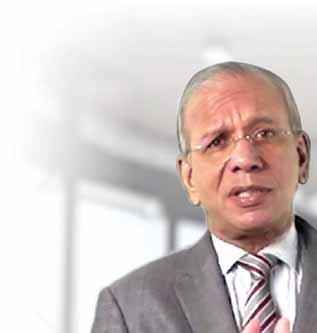


in these two months, as against 271 last year. We were able to negotiate with USAID and formulate a partnership where they gave us $5 million to provide assistance to Italian communities impacted by Covid-19.”
The Trustee Chair said the challenge Rotary faces in a post-Covid world is to expand and institutionalise the learnings of last year.
So how was the TRF leadership gearing up for the post-Covid world?
It is working and succeeding in reducing its recurring fixed administrative costs, “and getting sharper and leaner, while protecting and safeguarding our brand.”
It is realigning TRF services and image “to the changing public sentiment. A case in point was making environment our seventh area of focus because the younger generation places greater emphasis on purpose, passion and meaning.”
It is exploring alternative ways of strengthening its World Fund; actively looking for external partners as it did in USAID, launching Programmes of Scale “where we put in up to $2 million and expect other partners who rely on Rotarians on the ground to equally invest substantially in funds and resources.” The Foundation has also decided to play a significant role in the distribution of Covid-19 vaccines, “especially in areas which might perpetuate insufficiency, inefficiency and ignorance.”
Ravindran said that since March 2020, many donors and other Foundation teams have been working around the clock, reshaping
priorities and practices for the next era of giving. “We must take heart from the reaction of the charitable public to the pandemic. What’s striking was not only the scale of capital being committed by major philanthropists — at least $10.3 billion globally in May 2020, but also how it is being given at record speed, with fewer conditions, and in greater collaboration with others.”
So this is the world of goodness out there and Rotary is a microcosm of that world. But the challenge remained in “meeting our funding goals”. In normal circumstances, TRF had set an achievable goal for this year of $410 million. The break up being as follows:
$50 million for Polio (matched by a $100 million from Gates)
$135 million for the Annual Fund
$85 million for the Endowment fund
$40 million for other outright gifts.
All this adds up to a grand total of $410 million.
Apart from the annual challenge, TRF’s mid-term goal of having $2.025 billion in net assets and expectancies by 2025 remained intact. “When we reach $1 billion in net assets, the funds available on an annual basis for spending would be $40-50 million.”
He added, “So far thankfully we are on track, keeping up with the projections.”
World economy in a tailspin
But the pandemic had sent the world economy into one of the worst recessions in recent memory. The misery caused by it constrains governments from spending money on social services necessitated “by the high
levels of unemployment, homelessness and poverty.”
This will create a dire need for the services of Rotary, which he was optimistic, “will thrive because in dozens of countries, we become the answer to the prayers of community members.” Such as parents with a seriously ill child who gets treatment at hospitals that Rotarians have built; of villagers who will escape serious renal ailments thanks to the safe drinking water Rotary projects provide; girls who won’t have to drop out of school at puberty thanks to the separate toilets Rotarians have built in their schools; or those who will escape death from cancer or devastation from malaria and other diseases thanks to Rotary.
Rotarians could give hope to thousands of such people because “of their boundless imagination, fierce ambition and uncompromising dedication even in this dark and gloomy year. Remember the night is darkest just before dawn breaks, so let’s have hope that this too will pass.”
Ravindran concluded with a famous scene from the Hollywood epic film Lawrence of Arabia where Peter O’ Toole, who plays the title role tells Omar Sharif: “Nothing is written”, after he saves Qasim, the Arab soldier who falls off the camel in the dessert, and others want to leave behind saying his death was “written”.
Concluded Ravindran: “All we can know is that with every action and reaction, there is an opportunity — a chance to live our values, express our desires, and take action to improve the quality of our lives. Nothing is written… till we write it.”
It was up to Rotarians to take all that is great about Rotary and TRF, “and use it to build a better world — for this is our great moment of opportunity.”

Rasheeda Bhagat
The Covid-19 pandemic has taught scientists engaged in public health many valuable lessons, and the first one is that investment in public health is crucial. “There is no getting away from it,” said WHO chief scientist Sowmya Swaminathan addressing the RI zone institute.
But this is a tricky investment, because its success means the absence of outbreaks of epidemics and pandemics, and people could say this investment was not needed as everything is fine. But then everything remained fine only because of preparedness and investment in prevention. “We, human beings, are reactive by nature and generally go from a cycle of panic to neglect.”
As happened last year due to Covid-19. First there was panic and now with the vaccination beginning, people were
advocating “business as usual, saying we are not going to have another pandemic in our lifetime. But that is not t rue. In p a nd emics , the question is not ‘if’ but ‘when’.
So as in the past, we should not go back to a cycle of neglect,” she said
Another lesson pertained to the importance of “public health awareness. Practically all countries, both high and low income, have been found lacking. Even countries with very sophisticated and advanced tertiary healthcare systems are facing huge mortality due to Covid-19 because they did not have the essential public health services needed for containment, surveillance, isolation and contact tracing, quarantining and engagement with the communities to ensure they are complying and cooperating.”
The other lesson from the pandemic is that “as we already know, these viruses jump from animals to humans. It is because of climate change, deforestation, animal-human coming together, the farming of wild animals in many countries, the markets where wild
and domestic animals are sold together. And the way people live. All these encourage the mi x i n g o f an i ma l and human virus and emergence of new strains which can then infect humans and become very dangerous.”
This has happened several times
Sowmya Swaminathan chief scientist, WHO
in the past including with SARS, Zika, Ebola, Nipah, etc. “The point is that we are going to have future pandemics and need to be prepared by giving importance to investing in a public health workforce and primary healthcare systems.”
The latter, said Sowmya, went well beyond “only having a centre where you do diagnosis, and give medicines and treatment. Primary healthcare has to work on health promotion, disease prevention and all this through community engagement.” This aspect has been missing from primary healthcare systems across the world and “this is where Rotary can play an important part... in promoting health literacy.”
The final lesson she has learnt is that it is important for both political and other leadership “not only to be strong, but also humble and compassionate. Because this virus has taught us so many things. We need to be humble and can’t assume that we human beings know and can conquer everything. We need to be compassionate, because many, many people suffered and continue to suffer.”

stron g , b pass i on a us humb human b everythin sionate,
Unf o brunt of those t om an d informal were j u s who wer now s eral child i n C h en n
partici of mobil
Unfortunately, she added, the brunt of the suffering has been borne by those who are already at the bottom and struggling to survive... the informal workers, daily wagers, who were just making ends meet, those who were just progressing a little in life. And all of that has been set back now by several years. She had met several children, particularly girls, both in Chennai and a village where she recently travelled, who weren’t able to participate in online classes for lack of mobile phones or internet.
Recalling the long journey of WHO and RI, WHO chief scientist Sowmya Swaminathan said that even though 2020 has been a challenging year, “there is a lot to celebrate, particularly in polio.” The first was the elimination of the wild poliovirus from the African continent.
“This has been a long, painful, stepby-step process, taken up country by country, district by district and village by village, with a few countries really posing challenges. With Africa being certified polio-free, that leaves only Afghanistan and Pakistan.”
Another milestone this year was the approval of emergency use of the novel oral poliovirus 2 vaccine, the first vaccine to get WHO ‘emergency use’ listing. “And we are now looking at all these new Covid-19 vaccines.”
On the downside, Sowmya added, in 2020 because of the pandemic, the polio programme was adversely affected, just like many other health services across the world. A pulse survey done in July-August by the WHO in 120 countries found major disruptions
“Young women have suffered too; there has been an increase in domestic violence and trafficking of women and girls dropping out from schools. At one point 1.6 billion children were out of school. Currently it is still several hundred million children who are not only missing out on educational opportunities, but also on midday meals.”
For Rotary, there were many challenges ahead; of course, the last mile on ending polio has to be traversed but there were also other challenges like tuberculosis, which Rotarians are already tackling. “We all will also have to help with the education of young girls and boys who are facing difficulties because of the

in essential health services. Topping the list was routine immunisation which took a hit by 70–80 per cent in these countries, with the low-income countries being more impacted. In essential health services, 50 per cent were impacted in the poorer countries compared to the richer ones.
India saw a 50–60 per cent reduction in TB notification “because diagnostic machines were repurposed for the use of Covid-19. “The TB control programme and almost all other healthcare staff were repurposed for Covid-19. And people could not reach health centres because of the lockdown, lack of transport and fear of being infected
pandemic; we need to give a helping hand to these kids so that they can come up. We may say everything is digital and we live in an online world, but there is a digital exclusion as well. So the engineers and technocrats should think of ways to bridge that digital divide.”
Sowmya added that “on the human side, there needs to be compassion, we need to look out for each other, especially the less fortunate, as it is going to take a couple of years for them to get back to normal.”
Ending on a “bright and optimistic note” because the vaccines are coming, she added: “I believe there will be several vaccines that are safe and effective for Covid-19 so that a good chunk of the population can be vaccinated to
by Covid. For all these reasons, surveillance and treatment for diseases like TB and malaria, anti-natal and young child services, non-communicable diseases like diabetes and hypertension programmes, essential surgery, blood transfusion were all affected, and cancer care was badly hit too.”
The polio programme also suffered; “we saw the frontline staff, who work on the ground for polio surveillance, being redeployed for Covid programmes. Their skills, experience, relationship with the communities came in very handy when overnight a new surveillance programme had to be set up for a new disease.”
Elaborating, the scientist said this means “that if you have a well-trained and well-functioning workforce, you can actually use it for multiple purposes.” In countries, where polio was under control for many years, that “workforce needs to be retrained and redeployed to monitor and keep an eye on both communicable and noncommunicable diseases, and engage with the community.”
create immunity. But this is going to take time. It will not happen overnight and not in the first half of 2021. But it will start happening in the second half of 2021, so we still need to be very careful and follow all the stipulated public health measures. We will see light at the end of the tunnel but we still need to walk through it. We need to walk together, supporting each other.”
She added: “Rotary is a great force, you have credibility, passion, the wherewithal and grassroots reach into the community. You have dealt with and almost got rid of one of the biggest scourges of mankind. Let’s continue to work together and think of innovative solutions to the common problems that we face.”
The future of Rotary is what you have created here… the kind of technological leap Rotarians across the world have made in the last 10 months. To be able to assemble a group like this and be together in a such a fantastic shared experience is the future. All of you were able to jump onto this kind of virtual platform so quickly and make it a global community,” RIPN

To commemorate her virtual visit, RCM donated two dialysis machines to the ACS- RCM Dialysis Centre that the club has set up at a hospital near Chennai. “This increases the number of dialysis machines available for patients with renal failure to seven,” said club president Kapil Chitale.

He added that club members had also planted 117 more fruit-bearing trees on its 35-acre plot that houses the RCM Boys Town Society, a flagship project of the club. The number of trees mark the 117 th year of Rotary starting in July, 2022, when she will assume the office of RI president.
Jennifer Jones said, while addressing two different meetings on virtual platforms, created by the Rotary Club of Madras, RID 3232, and the Synergy Rotary Friendship Alliance. The latter has been created and fostered by PDG Sunil Zacharia, RID 3201, with membership across 11 Asian countries. She said it was wonderful to see such a huge participation at both the events; while at the RCM meet, 525 participants from 25 countries logged in, at the Synergy meet 390 participated from all over the world, including three past RI directors, six district governors, 14 DGEs, and 10 DGNs and 35 past governors participated.
Jones said that Rotary’s international passport has never been so relevant as now. To be able to connect so easily and remove borders and boundaries is something that Rotary has done for decades and decades. “But to put that global stamp on our passport as we are able to traverse the world through these virtual meets is wonderful.”


While during the Covid pandemic, she had been on so many such virtual meets, and made new friends across the
We’ve been through many dark days in the last several months and there isn’t a man, woman or child who hasn’t been touched by this global pandemic. But in a unique way, this pandemic has galvanised us, and proving that we are people of action, we quickly realised the need to remain united, connected and together in shared service. You’ve all jumped onto virtual platforms and perfected them, as you’ve done today to bring along so many participants from several countries.”
The new year had begun with hope, and “one-by-one we are going to get vaccinated. And we are going to speak about it to our neighbours and friends because we are the vaccination people.
We stood up and said polio could be eradicated. And we now need to use our voices for those who have vaccine hesitancy and let them know this is a safe procedure which will prevent them from getting infected.”
Jones wondered if, as a Rotary leader had once told Rotarians in her region, “we had told Rotarians 30 years ago that we need you to immunise three billion children against the polio virus and raise more than $2.1 billion and it will take us over 30 years to eradicate this disease, would we have done it?” The likely answer is a ‘No’ because it would have been seen as an impossible task.
But thanks to polio immunisation, Rotary now has a public health infrastructure, formed along with its partners such as the UNICEF, WHO, the Gates Foundation, etc in over 70
countries, which was ready to tackle both polio and PolioPlus, the ‘plus’ in that would now be Covid, apart from malaria, tuberculosis, etc.
Jones added Rotarians were distressed to know that from March 2020, when the world went into a lockdown, we’ve had to take a pause in polio vaccination. “But just imagine, those frontline workers were able to pivot and go from being polio to Covid frontline workers. While they had to pause on polio vaccination, they didn’t pause on doing surveillance and contact tracing, to identify where Covid exists, so we could shut it down. This infrastructure also helped to shut down Ebola and we should be so proud of their efforts.”
world, “which is incredible, but man, I am looking forward to the day we can all meet in person. But to have made so many new friends, isn’t that incredible? It shows that Rotary’s future is incredibly bright. Thank you for the leadership you have shown. When we come out of this, and we will, this will remain because of the kind of synergy you are going to establish in the weeks and months ahead, before the ‘normal’ returns,” she told the Synergy meet.
On Rotary’s future, she said that each of the Rotarians who had made it “a priority to stay engaged and connected like this “is the future of Rotary”. But a challenge before all Rotarians was to look around their clubs and ensure that others too were having similar experiences, and were
involved with group meetings, not feeling left behind, felt cared for, nurtured. “When we connect, even though we might be locked down, people get the assurance that they are traversing through these challenging times together. We see on
The onus is on each of us to check on our club members on how they are doing with their mental health. There are so many stories of people struggling... losing money, jobs, etc.
the horizon hope, dangling in front of us as vaccines are here.”
That these Covid-19 vaccines had been manufactured and in the hands of people in less than a year was “magical. Till those vaccines open up to us, we cannot really travel the way we used to. The video you showed of Kerala makes me itch to travel, it is on my bucket list, and has been for some time,” she told the Synergy meet. She also hopes to make it in person for the Zone institute to be organised by RIDE A S Venkatesh in December 2021 at Mahabalipuram in Chennai.
But right now, the onus was on each and every Rotarian to think of their fellow members at the club levels, as this is an important ethos of Rotary — after inviting a person
At both the RC Madras and Synergy Alliance meets, RIPN Jennifer Jones was asked about promoting younger and women members in Rotary and how she had managed to break through the “glass ceiling” and reach the topmost position in RI.
Jones said that for “the better part of the decade we at Rotary have been trying to attract women and younger people under 40. This has been a priority, but quite candidly, the needle has moved in a negligible fashion in those two categories. Women and younger people who are looking for a leadership experience have to see that opportunity in Rotary.” She hoped that with the focus now being on “diversity at the highest level of our organisation, and with a woman president, this will hopefully inspire many female and younger members to join Rotary. I do hope this will challenge and be an inspiration to women to take on leadership positions, beginning at the club and then district levels. Showcasing the best practices of inclusion will foster growth.”
She said that even though Rotary needed “young thinkers, having a

prescribed age group is not the way forward.” All of us, she added had surely met a 25-year-old who thought like an older person, as well as an 85-year-old whose thinking and perspective were akin to a young person. “What we need is progressive thinking to take us forward.”
On bridging the gender gap, Jones advised Rotarians to take up this issue
from a “business perspective. If in our company we were looking at a market share that was underperforming, what would we do?”
For instance, female membership in Rotary was only 24 per cent women, though it was higher in some areas — in North America it was about 35 per cent and in the Caribbean region between 48–52 per cent. “We would
into Rotary, “ask them what they want out of that experience and then deliver it.”
Jones said often more attention was given to people who join and leave Rotary, than “focusing on those who stay behind and what their expectations are. The answer is quite easy; research tells us that they join for friendship and service. We all want to get our hands into something that makes a difference in our world,
and our vision statement tell us that we join together with people to create lasting change.”
But most important of all is the change that Rotary gives as an opportunity to its members to bring within themselves. “Isn’t the opportunity to improve our leadership capabilities and attain personal growth, a gift we can offer others, to join us in friendship and service,” she asked.
She advised Rotarians to check in on their club members to “to see how they are doing with their mental health. There are so many stories of people struggling, whether it is losing money, jobs, or food and other issues.” It was imperative to check that other Rotarians were not grappling with isolation or mental health issues, “so that people understand that even in the darkest hours there is hope.”
tweak our business plan. Similarly, let’s take the opportunity to bring a gender balance in Rotary.”
RI Director Valerie Wafer chairing RI’s new diversity, equity and inclusion taskforce said, “we need these challenging conversations in our own clubs.”
But she cautioned Rotarians that they would need to focus at “the best and brightest in both men and women. At RI, over a year ago we embraced and adopted a new diversity, equity and inclusion statement, and this is happening in governments, NGOs and companies around the world as well. So let us take a close look at how do we create a diverse perspective in our clubs. That will help us solve some of the world’s most pressing challenges. It’s because we are able to look at things from a different perspective, and bring together a mosaic of people from different regions, cultures, age groups and backgrounds, we’re able to solve some of the problems of the world.”
On women Rotarians overcoming the glass ceiling and getting mentorship for leadership positions is “something we need to be more mindful of when it comes to nurturing our members, both male and female and giving them leadership opportunities.” One way to achieve this was by ensuring
In a Q&A session moderated by PDG Shyamashree Sen, RID 3291, Jones said that in the coming times, e-clubs will have a bigger role, “they will thrive, survive and grow. Assembly of people from different parts of a country and even different nations will only grow. Actually, the pandemic has moved us ahead by 5–10 years as we have been forced to come out of our
that “the same people are not doing the tasks again and again; tap new leadership opportunities, give them these roles, along with the wings to fly. “We have to look for the best and the brightest, fresh ideas, and give opportunities to the new leadership to blossom and grow. The seniors and veterans should do that.”
As for reaching the top RI position, Jones said: “I did it just like my male colleagues have done; we have all filled different positions in leadership roles from the club president to the DG level, then serving on the RI board, one of the requirements for becoming an RI president. And I was also fortunate to be able to serve as a TRF Trustee and in different leadership positions participate in conversations with world leaders.”
Adding that there was an “opportunity for all of us, both men and women, to increase our leadership role in Rotary”, she said: “I was pleased, humbled ad excited by the opportunity to be nominated RI president, and this is a positive move forward for Rotary too. But I firmly believe I was not selected because of my gender but because of my qualifications.”
comfort zones and go into technological innovations and newer platforms.”
Answering another question, she said “diversity, equity and inclusion” will continue to get much more focus in Rotary. In her year, she would give this a priority “in a voice of authority. We will be viewing all three through different lens of gender, age, race, religion, culture and sexual orientation. I will be challenging Rotarians to have some of these difficult conversations
I was pleased, humbled ad excited by the opportunity to be nominated RI president. But I was not selected because of my gender but because of my
and ensure that we are a true reflection of what our community represents. In some parts of the world that dialogue might be of age, in other parts, of gender and culture.”
But even though this dialogue will differ in different regions, the end result will be the same, “making sure that we are a true reflection of our communities. It is the diverse and unique perspective each of us brings to our club that helps us tackle and solve some of the most difficult problems that our community or country faces. Because we come at it from different angles, we are able to challenge each other and give our very best. If we all looked at the problems through the same lens, we would not be so brilliant, shine so brightly and provide hope,” she said.
The RIPN congratulated RC Madras members for “playing such a crucial role in throwing out polio from India. Commending the club members “for the wonderful service projects that you do”, she added she was greatly touched by the two projects they had launched in her honour and said she would use the first opportunity to visit both in person.












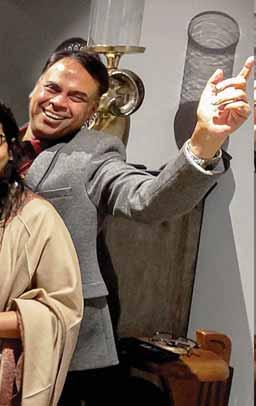






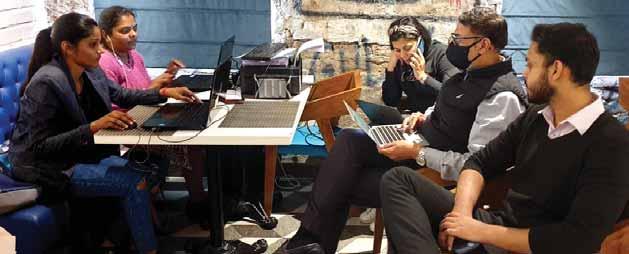

Clockwise from top left: From L: RID Kamal Sanghvi, Sonal, Mohak (Rtn Gagan Dudhani’s son), PDG Sandeep Narang, Shristi (PDG Sanjay Khemka’s daughter), Raavishu (RID Kamal Sanghvi’s son), Anu Narang, PDG Sanjay Khemka and Minakshi; Institute convener Kamal Sanghvi and Sonal; Institute chair Sanjay Khemka’s son Shubham and daughter Shristi, alongwith his office staff Snehlata and Kajal, managing the helpline centre; A nostalgic recall of the Institute originally planned at Kochi and promoted at Indore in December 2019: RIPE Shekhar Mehta, Rashi; RID Kamal Sanghvi, Sonal; and Madhavi Pandya with wives of IPDGs at the Indore Institute.


A dance performance at the institute.










Look forward to the next Rotary zone institute at Mahabalipuram, a heritage town replete with Pallava architecture near Chennai, on Dec 10–12.
“Mahabs Rotary Institute will be a stellar example of both purpose and pleasure as Rotarians can listen to eminent speakers in engaging sessions and also indulge in dance, music, fun, laughter and gala merriment in the backdrop of exotic beaches, enjoy thoughtful fusion and authentic delicacies at a luxurious seaside hotel,” said PDG M Muruganandam, RID 3000, event chair, at the virtual Rotary institute. In his address, RIDE
A S Venkatesh, convener, Mahabs institute, said the delegates would have an opportunity to network with Rotary leaders from the zones, attend interesting sessions and watch some awesome entertainment at “this
historic town that boasts of several heritage sites and lovely beaches.”
It is also close to other places of interest such as Pondicherry, famous for its Aurobindo Ashram and Kancheepuram, an ancient pilgrim town,

known for handwoven silk sarees and Kamakshi Temple. RI President Shekhar Mehta (2021–22) will be there as chief guest.
Mahabalipuram had served as the venue for the high-level summit between PM Narendra Modi and Chinese President Xi Jinping in December 2019.
What’s special about Mahabs?
A curtain raiser was screened on Mahabalipuram which was founded by the Pallava ruler Narasimha Varman during the 3–7th century, and named after the benevolent King Mahabali. Also known

as Mamallapuram, the ancient town that lies along the Coromandal coast, off the Bay of Bengal, 37 miles south of Chennai, is a UNESCO heritage site.
The Rathas, the mandapas, the Descent of the Ganges and the Lord Krishna’s butterball are a group of royal monuments that show the architectural genius of artisans here. Other highlights include the Shore Temple, the only surviving edifice of the legendary seven pagodas built by the three generations of Pallava rulers as it took “over 200 years to complete the entire site.”
Every year classical dance and drama festivals are held to preserve and celebrate the ancient culture of the Pallava dynasty, a visual treat for the eyes. The Mahabs Rotary Institute will be held at the Four Points by Sheraton and the adjunct seminars will be conducted at the Radisson Blu Resort Temple Bay.
RIDE Mahesh Kotbagi is the co-convener of the Mahabs 2021, PRID C Basker and PDG Abirami Ramanathan are the advisors, PDGs Surendra Bommireddy is the co-chair, Madhav Chandran the secretary and C R Raju will be the treasurer.
For more details, visit www. riinstitutemahabs21.org.

The very definition of the conventional role of corporates and social responsibility of business as merely pursuing legitimate profit and shoring up shareholder value is undergoing a definitive change, said chairman of the Aditya Birla group Kumar Mangalam Birla, while addressing the inaugural session of the RI zone
institute The Odyssey, convened by RI director Kamal Sanghvi. It was Nobel Laureate Milton Friedman who “famously and rather pithily said that the social responsibility of business is to increase its profits. Ironically, the 50th anniversary of that famous statement came bang in the middle of the Covid-19 pandemic. That statement had weight and logic which explains its longevity but that view is now changing,” he said. No less an organisation than
No less an than the Business Roundtable, an apex association of CEOs of America’s top companies had issued a statement in 2019, redefining the purpose of a corporation. Signed by 200 top CEOs, including those of JP Morgan, Amazon, has a broader umbrella of benefits to all stakeholders
Walmart, “their joint statement effectively underlines that the paradigm of business is moving from merely shareholder capitalism to stakeholder capitalism. That a corporation should not just maximise shareholder value but also the wellbeing of employees and the community at large. The words of Friedman, once treated as gospel, are now being questioned.” The new maxim of corporate responsibility goes beyond shareholder value, and has a broader umbrella of
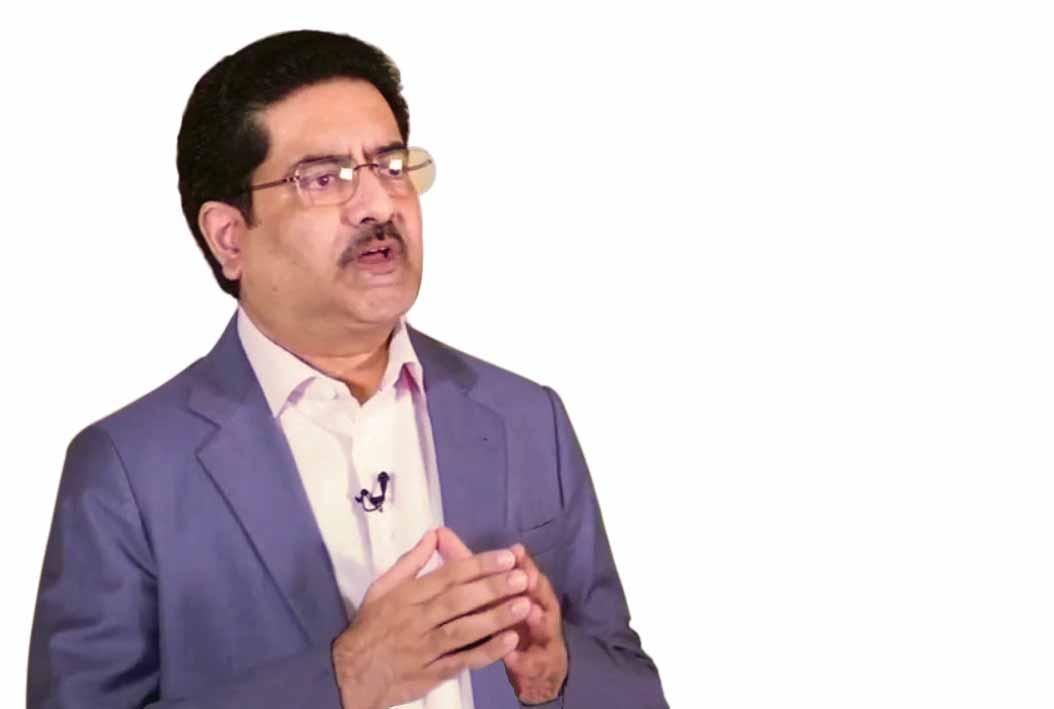
Kumar Mangalam Birla chairman, Aditya Birla group

irla added: “And I’d say that while doing so, it must also earn the implicit license to operate in society at large.” This is not the “conventional license that operated during the permit raj in India and which was dismantled 30 years ago. This is what I call the new paradigm for corporate citizenship. It is beyond just obeying laws and regulations, which now increasingly apply to the welfare of employees and safeguarding of the environment. Good corporate citizenship goes way beyond such legal compliance and is all about moral and ethical behaviour. Peter Drucker, the father of management, said a successful business stands on the foundation of morality, it is not
Commenting on the Covid pandemic Aditya Birla group chairman Kumar Manglam Birla said we have started the new year on a note of hope “not only because of the speedy development and deployment of the vaccine but also to have endured, survived and overcome the challenge of a great pandemic with such resilience, fortitude and determination such as shown by our Covid warriors — our frontline health workers, which is commendable.”
He said the year-long response to the pandemic across the globe reflected “all that is noble and uplifting in the human spirit. We witnessed the fearless and selfless dedication of frontline healthcare workers, the commitment and patience of people in law
an inanimate thing but is also expected to be humane, have empathy and be a caring friend of society.”
The industrialist added that in “this new paradigm, the license to operate has to be earned, through respect, credibility and acceptability.” It is based on genuineness and “willingness to match word and deed, abide by principles and ethics, no matter what. Such social acceptance has to be earned and no government or licensing authority can grant it.”
Actually, he added, this Business Roundtable statement was preceded by India’s landmark 2013 CSR law, “which looks in hindsight remarkably enlightened, and India is perhaps the only country in the world which
enforcement, and the spontaneous and generous support from the citizens to the governments in their efforts to contain the pandemic.”
While scientists, pharmaceuticals and others had collaborated to come out with vaccines in a record time, private enterprises and Rotarians too played such an “integral and stellar role in containing the pandemic and this is not the first time that Rotarians have played such an important role in a public health crisis. I am told that even during the Spanish flu of 1918, Rotarians were at the forefront of community service. Few institutions in the world can claim to have served humanity through the course of two pandemics, spanning more than a century like you have done.”
Birla said that even for business corporations, a crisis of this magnitude serves as a reminder of the need
to give back to society. “True to our legacy, the Aditya Birla group curated a multipronged approach to help local communities fight Covid-19. Apart from the Rs 500 crore financial contribution to Covid relief measures, our group distributed several hundred masks, PPE kits, disinfectants and food packets to the needy. We also earmarked hundreds of beds for Covid-19 patients in our hospitals across the country.”
Saying that every unit in every corner of the world of his group had “so selflessly come to the aid of the local community,” he added: “Personally, I was energised to see so many people in the corporate landscape, large and small, readily and spontaneously joining in collective effort to alleviate the pain caused by this pandemic.”
mandates that 2 per cent of after-tax profit should be compulsorily spent on CSR.”
The paradigm of business is moving from mere shareholder capitalism to stakeholder capitalism. Good corporate citizenship goes way beyond legal compliance and is all about moral and ethical behaviour.
But then, Birla said, corporations “like ours have been engaged in what is now called CSR for more than a century. My great grandfather, G D Birla, was a believer in Mahatma Gandhi’s view of corporations being trustees of social wealth. That spirit has always manifested in our community engagement. It is humbling to know that our corporation has touched the lives of over nine million people through our CSR exercises, so ably led my mother Rajashree Birla.”
Good corporate social citizenship goes well beyond lip service and is not just a tick mark of compliances,
Even during the Spanish flu of 1918, Rotarians were at the forefront of community service. Few institutions can claim to have served humanity through the course of two pandemics, spanning over a century.
motherhood statements or greenwashing as some critics have called it.
Maintaining that good corporate citizenship reflects the internal character of an organisation, “following a code of ethics and values which are its very foundation, and are articulated frequently and visible in the day-to-day operations and lived on a daily basis,” Birla gave a telling example. In the early days of the Covid pandemic, when panic buying was being witnesses all around the world, “a UK retailer opened its store one hour earlier every morning exclusively for senior citizens to buy their provisions. This simple gesture exemplified the empathy and integral values that all good corporate citizens must have.”
Responsible corporations should not only evangelise but get others to join the bandwagon by example, so that good corporate citizenship becomes a movement led by the private sector and not forced by the government or regulations. For example, “our fibre business insists on sourcing wood pulp as raw material only from suppliers who practise
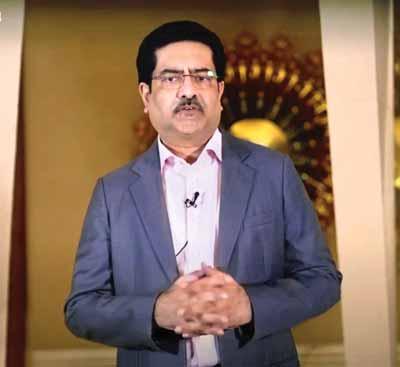
sustainable forestry. I am sure such behaviour will soon reach a tipping point,” he added.
Birla also underlined the importance of “the culture of volunteering” in a business organisation. When employees volunteer their time for community service or mentoring youth, they enhance the stature of their employer. He shared that during the height of the pandemic, when
During the height of the pandemic a call from our group elicited an overwhelming response with over 26,000 employees helping workers recharge their mobile connections. A corporation can encourage, recognise and reward such initiatives.
migrant workers were experiencing hardship, a call for help within the Aditya Birla group “elicited an overwhelming response with over 26,000 employees of the group helping workers recharge their mobile connections. A corporation can encourage, recognise and reward such initiatives.” Research has shown that employees feel good and energised to work for such corporations and even consumers are willing to value and pay a little extra for products made by companies who follow such desirable practices. “So there is clearly a tangible benefit.”
Quoting the four principles from Rotary’s Four-Way Test, Birla commented: “I find these to be simple but powerful thumb rules to guide the decisions of corporations.” He added that what he was advocating was not “antithetical to creating value and wealth. The leap from goodness to greatness for a corporation is not only the matric of sales and profit. There is an intangible element in good corporate citizenship.”

V Muthukumaran
Over the last one-andhalf years, Rotary clubs have done remarkable work in holding Know Your Numbers camps across the country. “Please continue the camps which can be held even in pandemic times as we are checking around 150–200 patients in a camp, hence Covid precautions and social distancing can be observed without difficulty,” said RI director Dr Bharat Pandya, in a session on Project Positive Health (PPH) at the virtual Rotary institute.
Every person must know his or her numbers — height, weight (both give BMI that indicate obesity), blood pressure (that points to hypertension and heart problems) and blood sugar for diabetes. “Obesity, hypertension and diabetes together account for the big NCDs, causing 60 per cent of deaths in India as Indians are culturally and genetically predisposed to these chronic, lifestyle diseases,” he said.
He warned that in India the NCDs occur 15–20 years earlier than in western countries. For eg, what usually occurs at the age of 60–75 in the west, occurs at 45–50 in India. “The burden

of chronic kidney diseases is the highest in India which is also the diabetic capital of the world.” During the pandemic, the death rate of people with comorbidities is much higher than that of the general population, he added.
One of the positives of the pandemic is the focus it has brought on the importance of good health and secondly, people with comorbidities, those with NCDs, are affected more severely, some of them getting admitted in hospitals and ICUs, he noted.
Ready-to-explode volcano
The NCDs is a volcano waiting to explode, he said and after a pause, added “let me correct myself. It has already started exploding and if we don’t do something about it quickly, then it is a big
problem we are leaving for future generations.” Dwelling on the causes of NCDs, he said improper lifestyle with too much stress; no physical activity like exercise; and bad food and bad habits are three main reasons for the huge spike in patients with chronic diseases.
Indian food is rich in cholesterol, calories, salt, oil and sugar. Bad habits like tobacco and alcohol consumption are on the rise. “People are not aware of the importance of regular check-up and need for lifestyle modifications,” Pandya added.
Rotary PPH has a threepronged approach to tackle NCDs in India — holding Know Your Numbers camps and popularising the slogan Ek chamach kam, char kadam aage through Rotary camps and events. Simply
put, the tagline urges you to take one spoon less of salt, oil and sugar in your daily diet and do at least 30 minutes of exercise daily to ward off NCDs. “Adopt this slogan in your life and also make your friends, families and business associates to adopt and implement it in their lives.”
Through awareness programmes in schools Rotary is trying to change the mindset of children on the importance of good habits, healthy food and the need to exercise. “They will go back and change the mindset of their parents, elders and relatives.”
As a surgeon, he added, “I am always committed to curative healthcare, but I realise that the future of healthcare lies in preventive care,” Pandya said. PPH is not just a 2–3 years programme, but it should be carried on for at least 15–20 years and beyond. Citing a popular Hindi saying for good health, he said, “keep your tummy soft (diet control), feet warm (regular exercise), and mind cool. If you do the three things, you can overcome and defeat NCD illnesses,” he added.

Ranjit Sinh Disale, a teacher at the Zilla Parishad Primary School in Paritewadi village, Solapur, Maharashtra, won $1 million as Global Teacher Prize 2020 for promoting girls’ education and introducing a QR-coded textbook revolution in the country. The annual award is instituted by the Varkey Foundation, UK, to honour exceptional teachers for outstanding contribution to the profession. “I have announced that I will share half of the prize money with
my nine fellow finalists. It can help scale up their work too. Teaching is all about giving, sharing our knowledge and making people competent,” he said, speaking at the virtual Rotary institute at the RILM session.
In 2009 when Disale arrived at his school, which was a dilapidated building sandwiched between a cattle shed and a storehouse, his immediate task was to ensure that textbooks were available to his pupils in their local language. “I translated the textbooks in Marathi and also embedded

them with QR codes to give students access to poems, video lectures and assignments.” His idea was adopted by the NCERT in Maharashtra. “Children unable to visit schools can still learn their lessons from home at their own pace.” He proudly says that 90 per cent students in his school have achieved excellent grades. Without leaving their classrooms his students have travelled to 140 countries ‘virtually’. “They know the culture and language of the people there. It has helped to broaden



After interacting virtually with Japanese children, my students understand how to respond to earthquakes, because it is a common phenomenon in Japan.
their vision. I encourage them to call themselves ‘global citizens.’ After interacting with Japanese children, my students understand how to respond to earthquakes because it is a common phenomenon in Japan,” he said, adding that he plans to allocate 20 per cent of his prize money for his ‘Let’s cross the borders’ project that aims to build peace among students and young people from conflict-torn countries such as Pakistan, Palestine, Israel, Iran, Iraq and North Korea. He also wants to allocate another 30 per cent of the prize money to the ‘Teachers’ innovation fund’ that he plans to set up.
The impact of Disale’s interventions is that there are now no teenage marriages in the village and the school has 100 per cent attendance of girls.
RIDE Mahesh Kotbagi, co-chair of RILM, said that about 300 Rotary clubs with a participation of one lakh Rotarians from across the country have been working on RILM’s TEACH programmes since its inception in 2014. With the onset of Covid, after which schools had to be shut down, “Rotarians such as Swati Herkal have trained

80,000 teachers in western India in simple, smart online teaching methods and it is being scaled up to benefit teachers nationwide.” The e-shiksha project has helped install audio-visual curriculum in 30,000 schools. The content is approved by the government and is being telecast nationwide and in its educational app, Diksha. “It is expected to help around 15 crore children across India this year.”
Thanks to Disale’s interventions, there are now no teenage marriages in the village and the school has 100 per cent attendance of girls.
RILM is involving school students to mentor adult illiterates in its adult literacy programme. “At least 80,000 adults are functionally literate, thanks to this initiative,” he said. Programmes such as Swabhimaan, Project Dignity and Saksham Bharat are making a great impact in enhancing livelihood of women and youngsters through various skill development programmes by involving Rotary clubs. More than 1,000 single women have found suitable vocations through Project Dignity. Through Project Saksham Bharat RILM encourages Rotary clubs to enroll youth in any of the branches of Apollo Medskills in their region. The course fee that has been subsidised at `4,400 per student will be sponsored by the clubs. Placements are assured for the trainees on completion of the course.
Around 3,000 Happy Schools and 3,500 libraries have been facilitated through RILM across the country, added Kotbagi.

Kiran Zehra
One of the critical goals of Rotary clubs is to listen and recognise what Rotaractors want and give them an opportunity to shape their experience by being more flexible, said RID Valarie Wafer from Canada, anchoring a session for Rotaractors that saw participants from Europe, Africa, Australia, Brazil, Japan and South Asia. She was addressing a session at the zone institute.
Rotarians must continue their dialogue with Rotaractors and reach out to them for ideas and suggestions, she said. Samantha Fewster, chair, Rotaract Australia Multi-District Information Organisation (MDIO), said “Rotaract offers an incredible opportunity for young people to learn and grow with other people in a supportive environment at a similar stage in their life. We learn leadership and business skills, and other useful skills through our service to the community.” She asked Rotaractors to apply these skills in their daily lives, workplace and local communities. The new skills will help them if they want to take leadership roles in Rotary in the near future, she said.
The decision to elevate Rotaract on par with Rotary, she said, will make “years of service in Rotaract count when Rotaractors choose to join a Rotary club. This means that young people will be able to take positions that were denied to them previously for want of
otaract nity for w with nvironife. We lls, and service otaracir mmunithem if oles in aid. aract ill ct se ns o d f
experience.” Making Rotaract a part of Rotary will “allow a wider demography of people to take on leadership roles to better represent their communities and bring unique perspectives to the table, so that Rotary can truly change the world,” said Samantha.
On the upper age limit for Rotaractors being removed, Ojas Joshi, DRR, RID 3141, said this has enabled the Rotaract clubs to decide on their projects, the impact they wish to create, and also the people that they want to engage with. “Many Rotaractors
RID Valarie Wafer


across the world can continue being Rotaractors while embarking on their Rotary journey,” he said.
Nishita Pednekar, past DRR, RID 3170, said the removal of the upper age limit wouldn’t deter young individuals from joining Rotaract. “We join this organisation with the aim of self-development by serving the community,” she said.
Patricia Kuhn, member, RI Rotaract Committee and special adviser to Trustees from Brazil, said TRF Trustees are encouraging Rotary clubs to work with Rotaract clubs on global grants. TRF has made it possible for “Rotaractors to use global grants in their projects. We first have to learn how to use this resource, and who can teach us better than the Rotarians themselves. Besides, this is also a way to get closer to Rotarians.”

On being the first Rotaractor from Brazil to be selected as special adviser to TRF trustees, Patricia said, “I have learned a lot from the trustees. They show us that when different generations work together, our knowledge and ideas come together to build an even more solid future.”
Rotary’s partnership with Toastmasters is an “exciting alliance,” said Karthik Kittu, past DRR, RID 3190, and founder president, Rotaract South Asia Multi-District Information Organisation (RSA MDIO). “This partnership will help Rotarians and Rotaractors

grow personally and professionally. It will also help us strengthen the skills of Rotaractors and help them make a better impact in their communities,” he said.
Ronald Kawaddwa, chair, RI Rotaract and Interact Committee, Uganda, answering a question on whether dual membership for Rotaractors will be beneficial to Rotary, said, “Yes, it does in two ways. One, you are an equal member of both Rotary and Rotaract. Two, young Rotarians can be good mentors to Rotaractors who join Rotary clubs.” Rotary clubs, he said, should embrace younger members because they serve
as ambassadors who will encourage Rotaractors to join their clubs.
Kazuho Sano, Rotaract vice-secretary, RID 2840, Japan, said that he is looking forward to play an active part in Rotary and is hopeful the newly-introduced Rotaract dues will not affect membership. “Students or working members on an average spend $300 for coffee annually. All we have to do is convert our coffee dollars as dues,” he quipped.
Yatin Sehgal, president, RSA MDIO, said the recent RI amendment that Rotaract clubs can be chartered with or without sponsoring Rotary clubs is a revolutionary decision. Talking about numbers, he said, “Over the past six months, we have seen an increase of 1.65 per cent in the growth of Rotaract clubs as compared to the last three years. In Southeast Asia, the response is amazing because we already have around 261 Rotaract clubs coming up.”
From RI President Holger Knaack’s home district in Germany,

Doris Grimm, chair, RI Rotaract Committee, said that it was beneficial to have direct representatives as advisors to both the RI board and TRF. “By having advisors to these two boards, we show that we are not only talking but actually acting upon Elevate Rotaract,” she added. Calling the youth of today “a vehicle of social change,” Akansha Sanghvi, charter president, RAC Mumbai Zenith, said to promote fellowship through service “people must join hands and come together for a cause that can create everlasting change.”
RCMalegaon, RID 3142, organised a medical camp at Tatani, a remote village in Baglan district, Maharashtra. Over 800 villagers including women and children benefitted from it. Over 20 doctors attended to patients with issues pertaining to blood pressure, diabetes, arthritis, and infections of skin, eyes, and ears. Eleven patients with cataract were surgically treated at the Malegaon Rotary Eye Hospital for surgery. The club had arranged transport
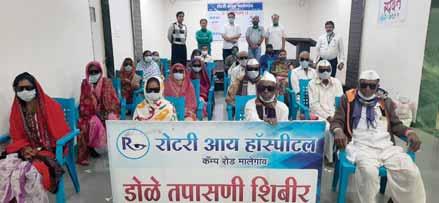
Patients at the Rotary Eye Hospital after cataract surgery. and food for the patients and their caretakers.
The visitors to the camp were given face
masks and sanitisers and the doctors advocated them to follow all the protocols such as handwashing, use
of masks and sanitisers and maintaining social distance to protect themselves from Covid.

V Muthukumaran
The need to save the environment and our planet so that future generations can live safe, secure and happy with plenty of trees and biodiversity, was the single-point agenda of the two insightful sessions at the virtual Rotary institute. Ecology warrior Vandana Shiva and nine-year-old Licypriya Kangujam from Manipur, discussed issues such as climate change, pollution, epidemics and eco-friendly organic farming to ensure sustained prosperity for human beings in an ecosystem that respects the wellness of all living beings including plants.
This pandemic is considered a health emergency, “but we fail to understand that there were pandemics and epidemics in the last few decades as we have deregulated commerce and celebrated greed as the highest end of human activity which is measured in terms of economic growth,” said Vandana. Wealth is created by extraction from the earth, farmers, societies and communities. “But true growth should promote growth of trees, children’s well-being and community welfare,” she said. out as it has measured its wealth by Gross National Happiness instead of GDP or GNP.
Conquests and militarism are at the roots of violence against the earth and people, leading to divisions in society. “The inequalities in our society have become
f economic growth , said Wealth is created extrache societies un i t i es. “But true g rowt h mote of trees, chill l-bein g and commun it y sh e sa id B h utan stan d s s measured its wealth onal instead ests and militarism are of violence the eople, to diviciety. have become
absolutely unbearable, for 0.0001 per cent of people control more wealth than half of humanity. We forget that pandemic roots are in ecological destruction and over 300 epidemics have come as our greed invaded the forests in the name of feeding the world.
Corporates vs well-being Vandana observed that only 10 per cent of genetically-modified soyabeans grown in the Amazon forests by burning the lungs and livers of the earth are used for human consumption, the rest go to animals and biofeed. “We are destroying the very fabric of the earth for a handful of companies.” Nearly 20 per cent of greenhouse gas (GHG) emission comes from destruction of forests in the last 2–3 decades. If we add to it the contributions of industrial and global food systems, that is destroying our health, “we are

talking of 50 per cent GHG emissions from non-sustainable food supply system,” she explained.
In the early 1970s, the Chipko activists hugged the trees on the foothills of the Himalayas to protect its rivers and mountains. At the Navadanya Farm, a biodiversity hub, in Tehri Garhwal over 2,000 crop species, 750 rice and 250 wheat varieties are grown through organic farming. “Food is the currency of life; our health begins with food. A non-sustainable, unjust food system is behind all emergencies we face, including climate change, existential challenges, health and pandemics. When you apply chemicals, then the food turns counterfeit. Chemicals are not part of the nutrition cycle as they kill soil microorganisms, the butterflies, bees and pollinators that give one-third of our food.”
is our we are Our food has lost 60–7 of nutrients due to chemic culture and then we fabrica our food as food. “W farmers for which will make ou obese and diabetic.” Biodive health of our an will have to n us in n the e jo decade to create an econom that earth,” she p


Our food has lost 60–70 per cent of nutrients due to chemicals in agriculture and then we fabricate a part of our food as junk food. “We pay our farmers just 0.04 paise for a packet of chips which will make our children obese and diabetic.” Biodiversity is the health of our ecosystems and “Rotary will have to join us in the journey next decade to create an economy of care that regenerates earth,” she pointed out.
Pass climate laws for world leaders to find and perma tions to and oth ical crises, up in Bhubaneswa
Calling for world leaders to act now to find long-term and permanent solutions to pollution and other ecological crises, Licypriya who grew up in Bhubaneswar, said she
had to drop-out of school in 2019 as she could not commute to Delhi from Odisha frequently to stage protests in front of the Parliament and “my father could not afford the travel expenses. I miss my friends, teachers and this is an emotional time for me.”
She is urging PM Narendra Modi and the MPs in Parliament to pass climate change bills into laws to control carbon emissions and GHG. She wants climate change to be included in school curriculum so that India mounts a fight at the grassroots level. Licypriya has launched the ‘Monday for Mother Nature’ drive for schoolchildren with a target of planting one million trees a year; so far 3.5 lakh saplings have got new shoots.
Doing Good with TRF help
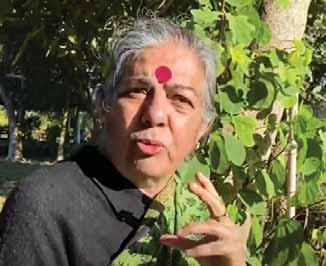
Painting a gloomy picture, she said the bushfires in Australia, and California wildfires to destruction of Amazon and Siberian forests to melting of the Himalayan snow caps and rising sea levels, have all contributed to make the
earth warmer. “Many children lost their homes with climate change becoming a global emergency, but our world leaders don’t have the time to talk to us,” she said.
The best gift one can give her children is not an expensive car or wads of money, “but a beautiful planet for which we need to change the world, starting from the family.”
The founder of The Child Movement recalled that taking part in the UN’s disaster management conference in Mongolia as a six-year-old was a life-changing experience for her and Greta Thunberg from Sweden influenced her thought process. She was the recipient of the Global Child Prodigy Award 2020 by Puducherry Lieutenant Governor Kiran Bedi in New Delhi.
Sixty-six
little children hailing from underprivileged families were surgically treated for congenital heart diseases at the Satya Sai Sanjeevani Hospital in Palwal, Haryana, thanks to the dedicated efforts of RC Gurgaon Harmony Iberis, RID 3011. The surgeries costing `1.65 crore were sponsored through a global grant support from RC Fort Wayne, RID 6540, USA. The children came from various states across the country. Club president Mukta Malhotra, past president Abdul Aziz Seyid and club member Vivek Gour together contributed `29.6 lakh towards the project.
njeevani in Palwal, ted efforts of RC Gurgaon
The surgerponsored ort from USA.
ri ous C lub past yid ur kh es, he s
In sponsoring the surgeries, Rotary has not only saved the lives of these children but it has also given life to their families, said Mukta at a simple
Club
event organised by the club at the hospital to cheer the children and their families. Gift of Life certificates, along with some toys, were given to the children in the presence of DG Sanjeev Rai Mehra, PDG Vinay Bhatia and district secretary Mohit Anand Bhatia. The members of the partnering club, along with DG John Frische from the US, joined in the celebration through a virtual platform.
with some toys in presenc
PDG Vin M bers wit U th an
tal. “W hosp theat
We ho

The club provided a heart and lung machine to the hospital. “We have been supporting the hospital in building its operation theatre and an ICU through GGs. We hope to have such larger and deeper associations as over 15,000 children are registered and awaiting treatment and many will not live long if left untreated,” said Mukta.
childre treatm if
OUR PRIORITY
THIS IS OUR ACTION PLAN. WE’RE
Reimagining how we connect and serve
Our Action Plan calls for us to become more nimble, responsive, and open to new ideas. As the Covid-19 pandemic has shown us, the world can change fast — and in ways we can’t always prepare for.
But we’ve also learned our members are resilient and willing to use every achievement and setback as an opportunity to learn and innovate. We can balance the old with the new — and create the kinds of experiences, relationships, and structures that will carry us forward.
What we will do
Use technology to make more connections and create new opportunities for participation
Listen to diverse voices when making decisions about Rotary’s future
Create space and resources to support and test novel ideas
Improve governance models, structures, and business practices.
Build
A fund for trying new ideas or activities
Try
A new meeting schedule, location, or format
Re-evaluate
Your governing structure to be more effective
Invite
Non-member advisers to share new perspectives
Want to know more?
Read the full Action Plan at rotary.org/actionplan.
V Muthukumaran
Each one bring one will be the new membership slogan that will be launched in the first week of February, along with Rotary’s annual theme, “as we want to shift the responsibility of membership growth from the topmost level to the club, grassroots level,” said RIPE Shekhar Mehta speaking at a webinar hosted by the Eastern India Lions Leadership Academy. He expressed concern over the fact that due to the pandemic, money allotted for the development programmes, is being diverted for vaccines and immunisation drives.
“We have to contend with rising job losses, dropouts from schools and poverty in the current situation,” he said.
On the positive side, the pandemic has taught some important lessons for us to lead a better, healthier life.
“We have to respect the environment. A healthy lifestyle with family as the key is critical for us to stay connected with our dear ones. We have to adapt to a minimalistic approach to life with a hybrid outlook as the way forward,” Mehta elaborated.
The RI board has taken a decision to participate in the Covid vaccination drive and “we will leverage from the brand we have created in polio eradication.” Rotary is in touch with the state governments and “we have been invited by some to play a role in the vaccination.” He cited the recent help sought by a top UP bureaucrat in kicking off the vaccination process in India’s biggest state as he was aware of the “Rotary doctors
and paramedics who are acquainting themselves well as frontline warriors in the fight against the coronavirus.”
Both Rotary and Lions must come together to collaborate and complement each other as there is growing demand for humanitarian services in the world, he said. “While Lions have excelled in eyecare and related services, Rotary has different focus areas such as literacy, water and sanitation. We should work in tandem with corporates and local governments. To begin with we can start with a small project, but without forgetting the larger picture,” he said. Both the organisations must forge partnerships at the grassroots level to make an impact as “we have done in polio by forming a broad alliance with the WHO, UNESCO, the Gates Foundation and other local organisations.” Recalling that he had set up 15 eye hospitals (11 in West Bengal), he said that Rotary will be more interested in sharing expertise with Lions which is known for its contribution in the eyecare field.
When he takes over as RI president in July 2021, he will be presiding over an RI board which has nine women among its 19 members. “It said . Both t he orge partnerts level to “we have o rming a he e s Founal hat he had i tals d that ted in n s w hi c h i s i bution
takes at least 30 years for women to rise up in the Rotary hierarchy from the club, district to the top-most level. Now that the glass ceiling is broken with the appointment of RIPN Jennifer Jones, I hope the gestation period will shorten for women leaders to claim their right place in Rotary,” he said. Mehta was confident that this webinar would have a domino effect “leading to action on the ground for us to evaluate further and take the collaboration to the next level.”
RIPN Jones said both the service organisations were trying hard to “find the right matrices and measuring


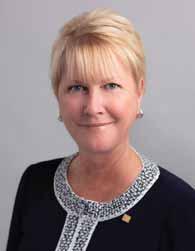
tools to evaluate the impact of their community projects. We are economic engines that drive the world. Though Rotary has disbursed around $29 million through Covid response grants and other grants, at the district and club-levels we would have done relief projects worth over $100 million.”
Women’s membership in Rotary stood at 25 per cent and “they should be given opportunities to develop their leadership skills. For this to happen, diversity, equity and inclusion are critical for our growth,” she said. Age, gender and sexual orientation are challenging issues which will have to be tackled for Rotary to expand its membership, Jones noted.
Douglas Alexander, first vicepresident, Lions International, from Brooklyn, New York, said, “we have to embrace change to adapt to new ways of communication for us to move forward.
Now more Lions are attending online meetings and our doctors and nurses are reaching out to families.” He recalled the efforts of Lions in cancer and diabetes treatment in New York to point out that using technology has made a big difference. “We need to share our success stories with rest of the world,” he said. Brian Sheehan, second VP, from
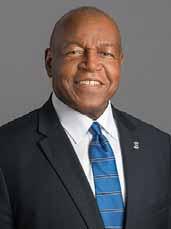
Minnesota and Dr Patricia Hill, third VP, from Edmonton, Canada, shared their perspectives on coping with the ‘new normal’. Past Lions International directors A P Singh and Sangeeta Jatia moderated the discussion that saw a participation of over 900 Rotarians and Lions from across the world.
Ina multipronged initiative, more than 20 volunteers from RC Jalandhar, RID 3070, came together to distribute winter jackets to 550 underprivileged families. “We formed micro teams for project execution across different parts of the city. The project was conceived and sponsored by PDG S V Hans,” said Jasmin Pannu, wife of club president Prabhpal Singh Pannu. A special distribution drive was conducted at the railway station for the benefit of coolies and other Railway staff

and the club organised programmes at places like sports academies and slum colonies for bulk distribution of winter jackets. The beneficiaries included rickshaw pullers, daily wagers, coolies, slum dwellers, physically-challenged
people, domestic help and street vendors, besides trainees at the Birring Hockey Academy.

Sporting qualities such as talent, hard work, integrity of purpose, respect for the opposition and the spirit of the game need to come together to achieve longterm consistency and success for sportsmen in their chosen field, said Rahul Dravid, former captain of India cricket team.
In a Q&A session titled Truth Talks with sports journalist Ayaz Memon, at the virtual Rotary institute, he said, “sportsmanship is
important for we have to respect the rules, regulations and understand the larger purpose of this activity. Don Bradman put it right that ‘you are just custodians of that sport for the time you are in it.’ It is not just that one is there in the field only to win, make money for 10–15 years and then move out.”
The 1983 World Cup win has changed the cricket scenario in the country. Till that time “Test cricket was the craze and along with other budding talent in the 1970s–80s, I aspired to become another Sunil Gavaskar, Gundappa Viswanath and Kapil Dev.”
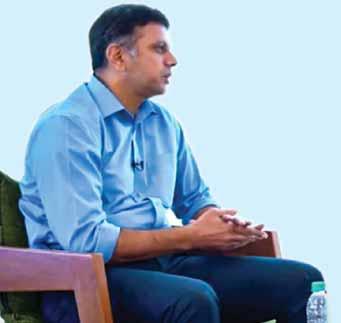
and getting financial benefits, but the respect you earn among youngsters in the country. It is all about how you carry and conduct yourself, for you do what you love and inspire the youngsters.”
Dravid led the Indian team for one Test series win against Pakistan on their home soil, then toured West Indies and won the series there after 35 years; and finally, beat England on its home turf in 2007, recalled Memon. Greats like Gavaskar, Sachin Tendulkar and Dhoni gave up Test captaincy after a series of losses, “but you gave up the leadership after a series win in England. Can you explain that,” he asked.
the 1970s80s, I Gavaskar, Viswanath and Dev.” about or
“Sports is not just about winning or losing
Facing setbacks, failures How did Rahul Dravid cope with disappointments, setbacks and failures in his career? Of course, not able to win a World Cup and getting knocked out early in the 2007 tournament still rankles him. “I had to face such failures and learn from it, but couldn’t dwell on it for long as we have to look ahead. We can’t think hard on past setbacks.” In 2004,
Former Team India captain Rahul Dravid in conversation with sports journalist Ayaz Memon.


Replied Dravid: “Soon after the series win in England, I realised that one needs to give 100 per cent energy and mental space for the captaincy and I felt that I was not there, it was dragging on me. I was mentally and physically drained and could not take it forward. So, I decided to give it to someone else.”
On captaincy qualities, the Wall of Indian cricket said, “it has to be a consensual leadership for
Doing Good with TRF help
gone are the days of an authoritarian or dictatorial tenor with information explosion giving rise to a need for pooling in collective intelligence, knowledge to achieve better results.” An India cricket captain must be able to blend harmoniously the collective skills and talent of his team members to achieve results on the ground, he said.
After winning the Under-19 World Cup in 2018, Dravid as head
coach got extra money, but “I asked for equal distribution of prize money (to support staff) as it is team effort and everybody contributed for our win.”
Dravid goes by his conscience and that is why he turned down the offer of honorary doctorate from the Bangalore University. “My mom got a doctorate in art at the age of 56–57. So we have two doctors in our family (his wife is a surgeon). But I did not
feel like accepting this award from the university for personally I don’t fit into this. I have got several awards such as ICC Player of the Year Award, Padma Shri, Padma Bhushan, etc for my cricketing abilities.”
Having conversations such as this one on sporting principles, roles, challenges, and acknowledging the mistakes of the past and learning from it is a great platform, Dravid added.
ICU unit was installed at the Dr Ulhas Patil Medical College and Hospital by RC Jalgaon West, RID 3030, through a global grant project by roping in RC Tallahassee, US, RID 6940, as its global partner. The project cost `34 lakh.
An exclusive Covid ward attached to this ICU unit has all ultra-modern equipment including ventilators, motorised beds, defibrillators, infusion pumps and monitors, among others. “The Covid ward is beneficial for not only corona patients but for other treatments also. This ward will be offered free for low-income families,” said Tushar Chitte, club president.
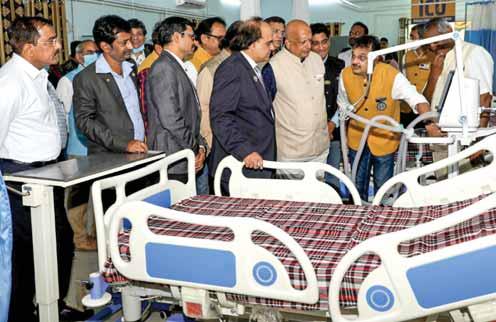
DGs Shabbir Shakir, RID 3030, Jane Pooley, RID 6940, IPDG Rajendra Bhamre, PDGs Kishor
Kedia, Rajeev Sharma, also the ARRFC, zone-6, Mahesh Mokalkar, DGN Dr Anand Jhunjhunwala, project chair Dr Sushilkumar Rane
and Godawari Foundation, Jalgaon, chairman Dr Ulhas Patil were present either physically or virtually at the ICU inaugural.

Preeti Mehra
With Rotary International making ‘Supporting the Environment’ its seventh area of focus, we bring you a monthly column ‘Go Green’ with practical tips on what all of us can do individually to save our planet.

There is no doubt that Mother Earth is going through horrid environmental changes. Rising sea levels, melting glaciers and extreme weather events like flash floods are all warning signals. If we want to halt this alarming trend, we can do a lot more than talk about it. We must act and get others to act.
It does not involve making any great sacrifice. The notion that adapting a nature-friendly lifestyle involves giving up on comforts, performing tedious and timeconsuming chores which take the fun out of living is not true.
All that is required is bringing about small changes in our dayto-day habits and the choices we make. Indeed, it will come as a surprise the difference each one of us can make in the long run by sensible use of our resources. The best ‘going green’ begins at home.
Let’s focus on water first. Saving this life sustaining nectar, everyone agrees, is the most effective and environmentally sound way to fight global warming. It is said that if we save water, it will save us in the future.
At every home, water is a precious commodity, though city
dwellers take it for granted. So, how much water do we consume?
Typical estimates have it that on an average every urban Indian uses 135 litres of water a day, of which only three litres are consumed for drinking. The rest goes into cooking (4 litres), bathing (20 litres), flushing (40 litres), washing clothes (40 litres), washing dishes (20 litres) and gardening (23 litres).
So, what are the steps each of us can take to reduce our water consumption?
Let us start with drinking water. Consuming it is of utmost importance, but the reverse osmosis (RO) system that majority of us use to purify water leaves a trail of wastewater. This impure water that is filtered out can be collected and used in a variety of ways. By putting a large container under the discharge pipe, we can collect the unpotable water which can be used for mopping floors, cleaning toilets and watering plants.
In the bathroom water can be saved through sensible use. Be mindful of not letting the tap running needlessly when you wash your hands, face, brush your teeth or shave. Bathroom taps typically run 7 to 8 litres of water a minute and if they are turned off while brushing teeth or lathering for a shave, the saving per month can be enormous.
The next time you need to change a tap, a shower or the flush
system, opt for a low-flow shower, faucet aerators and a dual flush or low-flow toilet. These new water saving designs and technologies can make a great difference. Also, make sure there are no leaking taps as a leaking faucet can waste 75 litres of water a day and a leaky toilet 700 litres a day!
Washing clothes consumes a lot of water. Minimise use by soaking clothes for a while. This can help in getting rid of the dirt in less washes. For those opting for washing machines, apparently front-loading machines use less water than top-loading ones. More important, if you are shopping for a new washing machine, do go for one that has a Bureau of Energy Efficiency star certification. The five-star certification is the best. These use 30 per cent less water and 25 per cent less electricity than regular washing machines.
Water saving can be done while washing dishes as well. Dish washers are not frequently used in the country, though they too come with star certification. The other method while washing with hand is to fill the sink with water and soap and soak the dishes for a while. Rinsing them then to make them oil and soap-free becomes a simpler task.
In several cities, rains come in plenty and it is easy to tap this rainwater for future use. Rain water harvesting systems are of different kinds.
Make sure there are no leaking taps as a leaking faucet can waste 75 litres of water a day and a leaky toilet 700 litres a day.
The elaborate ones come with a tank, pump and a purification system. But for a simple rain harvester you only need a large drum, or a rain barrel as it is technically called, that catches water from the roof, sidewalks and driveway through pipes and downspouts. The collected water can be used for hand-watering plants, the garden and even cleaning. But do remember to cover the drum with a lid or tarpaulin so that mosquitoes are kept at bay.
There is also wisdom in watering your plants in the morning as they require less water at a lower temperature.
Overall, the trick is in improving the efficiency of water at every step, reducing its loss and waste. Making every drop count as it were, and in turn promoting a sustainable lifestyle for everybody in our planet.
The writer is a senior journalist who writes on environmental issues.
Samir Kamra, member of RC Pondicherry Port, RID 2981, sponsored a desktop computer worth ` 50,000 to the Covid ward at the General Hospital and a flake ice maker worth ` 2.5 lakh to the Indira Gandhi Medical College and Research Institute. Flake ice has a variety of medical and laboratory uses ranging from
physiotherapy to instrument calibration and transportation of donated organs.
“It will also help in enhancing Covid testing,” said Rajesh Candamourty, club secretary.
Club president M Nandakumar, treasurer Shrikanth R D and Kamra, along with his wife Nalini, handed over the equipment to the hospital authorities.

The Covid vaccine has been rolled out in India on January 16 with the first shots being given to health workers and frontline staff.
Senior Rotary leaders in India have formed the Rotary’s Covid Vaccination Task Force in India headed by PRID Ashok Mahajan as its chairman to assist the government in the vaccination drive. “We have had initial discussions on how Rotary can partner in taking the programme to all citizens across India. Our expertise and network
in handling polio immunisation programme will be of immense value to the government, especially when it comes to countering some wrong perceptions that will arise from certain misinformed sections in the society,” said Mahajan in a letter addressed to the district governors. He has urged them to lead a team of volunteers and create awareness about the vaccine among the public. Wherever there is a resistance, proper information must be disseminated about its efficacy. “Our advocacy skills were proved in

breaking down the resistance during our polio eradication programme. Rotary has no mileage to gain from this except to save precious lives of people in every household,” he said, and urged Rotary clubs to seek the support of large organisations in their area for utilising their various facilities during the vaccination programme in addition to contributions for the cause.
“We will work together and show that no pandemic is too big for Rotarians in India to handle,” said Mahajan.
Mentor
Shekhar Mehta, RI President 2021–22
Chairman
PRID Ashok Mahajan
Zonal Coordinators (Assigned Districts)
Advisory Board Members
PP S K Jain, RID 3131
PDG Dilip Salgaocar, RID 3170
PDG D N Padhi, RID 3262
PDG Upkar Singh Sethi, RID 3070
PDG J B Kamdar, RID 3232
PP Ajay Saxena, RID 3120
PDG Jogesh Gambhir, RID 3250
PDG T K Ruby (3070, 3080, 3090), PDG Anoop Agarwal (3100, 3110, 3120), PDG Vinod Bhatia (3011, 3012, 3053), PDG Ashok Panjwani (3040, 3054, 3060), PDG Jayant Kulkarni (3030, 3141, 3142), PDG Rajeev Pradhan (3131, 3132, 3170), PDG Kishore Cherukumali (3020, 3150, 3160), PDG Manjunath Shetty (3181, 3182, 3190), PDG C R Raju (2981, 3231, 3232), PDG Sunil K Zachariah (3201, 3204, 3211), PDG Mukul Sinha (3240, 3262, 3291), PDG Vivek Kumar (3250, 3261), PDG Gopalakrishnan (2982,3000, 3203, 3212)
In a letter written to club and district leaders, RI Directors Bharat Pandya and Kamal Sanghvi have urged all the Rotary clubs in India to comply with the new norms and regulations implemented by the government of India for the voluntary sector. The letter says: “As you are aware, Rotary clubs are independent legal entities, governed by their respective constitutional documents and charter. However, whether or not a Rotary club is incorporated/registered, such club qualifies as a “person” under Section 2(31) of the Income Tax Act, 1961 and hence is a taxable entity under the Act. Every Rotary club has an annual budget of expenses and this amount is pooled in by the members, and has (income) receipts such as fees received from club members; sponsorship money for conducting seminars from third parties/advertisements revenues; interest on bank balance and deposits of the club etc.
Accordingly, clubs qualify as an ‘assessee’ under the I-T Act, where there is any income arising to the clubs that may be subject to income tax. Lack of registration of clubs and therefore not applying for PAN may be construed as Rotary clubs operating in contravention of the prevailing laws, ie, under Income Tax Act, 1961, read with the KYC norms issued by the Reserve Bank of India.
Due to not meeting these requirements, many Rotary clubs/districts have faced challenges while opening bank accounts for club and foundation activities. Each Rotary club/district is therefore expected/advised to act in conformity with Indian laws and duly
fulfil obligations. As these requirements cannot be overlooked, RI seeks cooperation of all the Rotary clubs/ districts in India without exception.”
To help decode what this means, RISAO has drawn up and answered some FAQs:
Why is a Rotary club’s registration so important?
RI has always encouraged its clubs to be compliant with the prevailing laws of the land. The Union Budget 2020–21, read with the recently enacted Finance Act, 2020, is focused on bringing in transparency in transactions under the head of donations/ voluntary contributions, A registered Rotary club can have its independent bank account, registered address and PAN, which are now mandates of KYC for all relevant financial transactions which could be scrutinised by an Income Tax Assessment Office.
What legal steps are required for registration?
There are different laws and corresponding procedures, governed by local state laws, which govern the registration or incorporation of any entity. It is advisable that you contact a local legal advisor or chartered accountant for the best options and procedures available for your club.
What legal compliances are required for a registered Rotary club?
Compliances for registered entities also corresponds with the laws under which your club may be incorporated/formally organised. Your legal
advisor/chartered accountant will be the best to guide you on the process.
Who is responsible for meeting with the compliances of income tax (or other statutory) authorities on yearly basis?
Depending on the law under which your club may be registered by your professional advisor, there would be certain statutory compliances. Your legal advisor/chartered accountant will be the best to guide you on the process.
Is the registration of Rotary club mandatory under Rotary Manual of Procedures?
No. Although, the Rotary Manual of Procedure does not mandate the registration of Rotary clubs, however, the Rotary Code of Policies does require all its member clubs to be strictly compliant and in conformity with the laws of the land.
Does the club need to submit PAN card/ compliance proofs with RISAO? No, the club is expected to have a PAN card and necessary records for KYC purposes.
Whom can we contact at RISAO for the registration process?
While we at RISAO are always happy to support and help, however, since the laws and procedures are specific and unique to each club, and in accordance with the local laws and procedures of the state in which your club is situated, RISAO can only offer the limited advice for you to reach out to the local legal advisor/chartered accountant.
Rasheeda Bhagat
We were so happy to visit the Jawaharlal Nehru Planetarium, where we learnt so much about science and found how in olden days people used to see the time through the sun, how the pendulum principle works, and that white colour doesn’t absorb heat and black colour absorbs so much heat. It was so exciting to see the optic tree, the whispering dish, where we could talk to each other without any connection. To watch the show which told us how the sun and all the planets were born was amazing,” gushed Sangeetha, a student from Vidyaranya institute in Bengaluru.
Added Meenakshi, a Class 8 student from a government school: “This is one of the most memorable moments in our life. We really enjoyed the visit and I learnt that the sun is one of the brightest planet and the exhibits will make our science learning easy.” Kala, from the Government Girls Home, Bengaluru, was euphoric, and said, “I felt like I was there in those planets and was taking a video while I was standing there!”

Her friend Amritha, who kept quizzing everybody on anti-gravity,
exclaimed: “I have learnt so many new things today and want to work here as a guide. I wish I could join tomorrow itself!”
Considered one of the top 10 planetariums in India, the sky-theatre shows here are immensely popular and are attended by about two lakh visitors every year. These blend science with literature, art, and cultural aspects of many countries using special animation, visual effects and videos.
But these shows, as well as the rest of the planetarium,
Students experimenting with acoustics at the Jawaharlal Nehru Planetarium in Bengaluru.

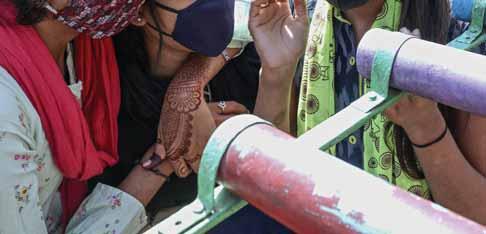


which was set up by the Bengaluru City Corporation in 1989, fell silent as the lethal Covid-19 virus compelled the planetarium, the city and the rest of India to lock down in the last week of March.
In November 2020, when this planetarium got permission from the government to reopen the sky theatre and science park, but with strict guidelines on proper sanitation facilities, social distancing and reduced capacity, keeping in mind the corona pandemic, its director, Pramod Galgali, reached out to S Jayaraman, a member of Rotary RT Nagar in Bengaluru. He needed financial support to put in place some of the statutory requirements such as foot-operated faucets at all public conveniences, sanitising stations at several points around the facility that is being managed by the Bangalore Association for Science Education (BASE), thermal screening facilities at the entrance, regular sanitisation of the sky theatre and contactless ticketing.
Jayaraman, who runs his own NGO in Bengaluru called the Integrated

Project for the Development of People, which also runs a home for 60 children, mostly from single parents and broken homes, has been in touch with Galgali, who has risen from the ranks to head the planetarium. “He is a wonderful person who is really interested in people benefitting from this planetarium. Over the years when he needs any support, Rotarians from our district (3190) have helped. I have helped in giving laptops and setting

up a computer lab at the planetarium too. So this time when he sought my help, I was able to get funding support from the corporae Kewaunee Labway India,” says Jayaraman.
But even though the planetarium opened, as schools are still closed and the people in the city were hesitant to visit a public place such as this, Galgali suggested that Rotary take up a project to bring in underprivileged children to the planetarium. “He agreed to waive off the entry fee of ` 40 for children to visit the sky theatre show for the month of December, and so we seized this opportunity and created a project titled Taralaya Pravasa.”
He next set about the task of finding 1,000 kids who were supported by various NGOs to visit the planetarium. A Rotarian for 31 years, Jayaraman has been working in the social sector for as many, or even more years. First of all, the Sankya Vidhya Foundation, which had been supporting the planetarium in other projects earlier, came forward to join hands with the Rotarians. Next, he approached other Rotary clubs and NGOs to create the logistics
and provide food to the children, so that they would get an enjoyable outing akin to a picnic.
Amember of Rotary Bangalore Orchards, Neil Micheal Joseph, who runs the Baghirathi Travel Solutions, “solved the major issue of transporting the kids. His buses are normally used to ply children to and from schools. But with schools being closed now thanks to the pandemic, he was able to provide us an airconditioned bus to pick up and drop the children, after the visit to the planetarium.”
Vincent Raj, president of RC Bangalore, connected him with one of his club members and a
Sri Sai Spiritual Centre Trust member, Srichand Rajpal, to help with the food. “Although the initial project was meant to take 500 little visitors to the planetarium, and hence 500 food packets were required, the number grew first to 1,000 and finally to 1,500 and we are happy that we managed to organise sumptuous and tasty lunches that every child enjoyed,” says Jayaraman.
The Rotarian was able to get the children to enjoy their lunch seated in a nice, green area at the complex, thanks to help from “two wonderful women, Thara and Chandrakala, who are social workers known to me. They spontaneously offered their services to bring food regularly from the Sri Sai Spiritual Centre and serve it with love to the children.”

Luckily, thanks to Covid, the cook who normally prepares meals for schoolchildren was free; his specialty is a vegetable pulao, and along with curd rice, this was prepared and served to the children, but only after Thara

Above: Rotarians S Jayaraman, Mohammad Tasleel, Ashok Mahadevan with Deepa Cholan, project director, Sarava Shiksha Abhiyan, and Pramod Galgali, director, Jawaharlal Nehru Planetarium.




and Chandrakala had explained to them the necessity of washing their hands with soap and offering a prayer of thanks before their meal. The director assigned them a place where the food was served and the children enjoyed a hearty meal. The children
were taken in different shifts over a few days.
RC Bangalore North West president Sumathi Rao, Manisha Vasan of Rotary RT Nagar, and Rotary Manyata president Tasleel all helped to provide the other support required. The programme

was inaugurated by Arshad, MLA of the Shivajinagar constituency. Mercy Mission, an NGO, provided chocolates to over 1,000 children. “The nicest thing about this project was that many Rotary clubs joined hands and identified and involved NGOs to get the children to the planetarium. A few Rotarians from each club came along with the children and this helped in the smooth conduct of the programme, and also helped provide the children additional snacks, which they thoroughly enjoyed,” he said.
He added that for most of the children, and even their adult caretakers who accompanied them, this was their first visit to a planetarium, and they found it “both an enjoyable as well as a learning experience. We do hope we have planted the seeds for at least a handful of future astronomers!”
Vani, a student from the Government Girls Home summed it up nicely when she said: “I never imagined that the universe is so huge; I now realise that we, the human beings, are smaller than a speck of dust. The food was super; I even took a small helping.”






































When former Prime
Minister A B Vajpayee passed away in August 2018, there was a spontaneous outpouring of grief. Even from those who are opposed to the BJP and its ideology, because by and large Vajpayee was considered a man of moderation. There was nostalgia for Vajpayee’s moderation and his ability to keep the ‘extremists’ on his side of the ideological fence under control.”
But this “nostalgia was misleading”, says Shakti Sinha in his latest book, a biography of the late prime
minister titled Vajpayee:
he was constantly criticised by several sections on various counts.
The closeness of Sinha, an IAS officer, who had spent long years as Vajpayee’s private secretary, when he was in power, and chose to stay with him, even when he wasn’t, is well-known in political and bureaucratic circles. Much has been written about Vajpayee, and yet Sinha’s book has to be read, especially for those who, despite being on the opposite side of the political fence, admired the late leader for his sense of fairness and justice and considered him a “dove among hawks” in the Sangh Parivar.

the foreign affairs portfolio, took great care to address each of the points raised by Vajpayee. “Even as Vajpayee was critical of Nehru’s policies, he seemed overawed by the latter. After Nehru’s death, Vajpayee’s eloquent eulogy in the Rajya Sabha (as MP there), was that of an admirer,” says the book.
Even in 1994, at the request of then PM Narasimha Rao, it was Vajpayee who led the Indian delegation to the UN and successfully countered Pakistan’s putting the Kashmir issue on the UN Human Rights agenda.





The years that changed India. He argues that during all his years in and out of power,
an era where
Sinha’s account takes us back to an era where political opponents were not considered devils or untouchables. He recalls that as a Jana Sangh MP in the Lok Sabha 1957, Vajpayee’s first speech was on foreign
He
as a Jana MP in the Lok Sabha 1957, first speech was on policy, which remained his favourite subject.
Prime Minister Jawahar Lal Nehru, who had retained

biograp is to do,







minister, the 1998, the fall of hi 13 months, and hi as minister complete a full ter


All da are but the b Sinh tion with his boss


Vajpa “a person, not





As any biography of Vajpayee is expected to do, the book does talk about Vajpayee’s terms in office as prime minister, the first one in March 1998, the fall of his government in 13 months, and his subsequent return as prime minister later in 1999, to complete a full term in government. All the required datelines and events are there, but the book is made more interesting by Sinha’s long association with his boss. For instance, he tells us that Vajpayee was by nature “a shy person, not at all a backslapping sort and slow to open up.” He had no godfather in politics, had risen to the topmost level by sheer merit and was “strangely very conscious of his limitations, and it was this that made him very successful.”
had no i risen to the topmo merit and was “str scious of his limita this that made him




A lot is written about his great oratorial skills; the author tells us how “people never understood how observant he was, how conscious of using the correct word at critical times and how much effort he could
A lot is written oratorial neve observant he was, correc mu

put into things that he found important. His pauses while speaking, were not just for effect but for precision.”
The book also gives us great insight onto the troubled Vajpayee government in 1998, which was jolted all the time by its own allies, principally AIADMK chief J Jayalalithaa, followed by TMC’s Mamata Banerjee. Two carefully chosen pictures — that of an anxious and frowning Vajpayee, seated before a Jayalalithaa perusing some papers, possibly a list of demands — and the next of a totally relaxed PM grinning in a frame with TDP’s Chandrababu Naidu, one of his trusted alliance partners, tell it all!
Jaya’s principal demands were withdrawal of the plethora of corruption cases against her and appointment of Subramaniam Swamy as the finance minister! Mamata kept storming out of NDA coordination committee meetings protesting that West Bengal was being “neglected”, and Jayalalithaa gave him endless pinpricks, constantly bickering about who should be included in the Vajpayee ministry and who should be dropped.
The author says that “one of the tragedies of Vajpayee as prime minister was that he was denied any kind of honeymoon period, either
Author: Shakti Sinha
Publisher: Penguin 351 pages `599

when he took office in March 1998 or after his Lahore visit, which should have been followed by days of basking in the sun.” The reference is of course to the famous bus ride to Lahore that Vajpayee announced in such good faith to improve Indo-Pak ties, and which boomeranged with Pakistan, more the army chief Gen Pervez Musharraf, rather than Prime Minister Nawaz Sharif, responding with the Kargil incursions which brought the two countries on the brink of war.
Earlier, the political drama in Delhi came to a climax with both Sonia Gandhi and Jayalalithaa attending a tea party hosted by Swamy in Delhi on March 29, 1999, famously known as “storm in a tea cup”. Finally, Vajpayee’s government fell by just one vote, and says Sinha: “I had never seen Vajpayee more distraught than when he walked back into his room in the Parliament House after losing the vote of confidence. He was crestfallen and in tears.”
Of course the Congress which ensured that this government fell, could not muster enough numbers
to form an alternative government, and Vajpayee was asked to head a caretaker government. Sinha adds that in the run up to the next election, “Vajpayee made it clear that Sonia Gandhi’s foreign origin would not be an issue, nor would the NDA run a personality-based election; he said that it should, instead lay emphasis on the real issues and the achievement of his government.”
The government fell in April, the Kargil incursion happened in May and on the intervention of the then US President Bill Clinton, on July 4, Sharif publicly committed to Clinton that Pakistan would withdraw forces to its side of the LoC. Looking back, it seems incredible that a caretaker government in India, headed by the very mature and astute Vajpayee, deftly handled the Kargil incursions and avoided a disastrous war.
Read this book to learn about the rise of Vajpayee, the qualities of the man that made him the endearing leader that he was and why he is being missed today. Though not a complete biography, it gives the reader an important slice of Vajpayee’s years in politics, what made the man tick, his friends and foes, etc. An important component of this book comprises details about the spearheading of important economic reforms by the late prime minister and how he skilfully manoeuvred the economy to ensure the country did not sink into an economic disaster after the imposition of economic sanctions following the nuclear tests in Pokhran in April 1998.
The man who emerges from these pages is an affable, moderate, articulate, reasonable, and yet a firm and astute leader, who could weave magic with his oratory and charm even his rivals. That he left an indelible mark on India is beautifully captured in this book.
V Muthukumaran

K Pandian
Over long years, Pandian has led many district projects that saw a participation of large number of Rotarians and their families, “thus creating strong bonds of friendship during special occasions such as Pongal vizha, Diwali and hosting polio marathons,” he says. The district has 97 clubs and 3,850 Rotarians, and he plans to induct 1,000 new members. He is sad that duing the corona pandemic, 300 members have quit Rotary in the district in the last few months. There are 75 Rotaract clubs with about 2,000 members in this district. But as colleges and schools were closed, it is difficult to add new Rotaract clubs now, says Pandian. Once normalcy returns, his district will take up disbursements of one lakh seed balls through choppers for which permission is in place. RC Gudiyatham will construct 65 new houses for needy families (GG: `1.5 crore), while RC Ranipet Sipcot will conduct a mega polio marathon in the last week of January. In healthcare, RC Tiruvallur Royal has inked a pact with the Government Hospital for maintaining its blood bank over a 10-year period at a cost of `85 lakh.
RC Tiruvannamalai Moon City has joined hands with the Tanker Foundation to open a dialysis centre with eight machines through a GG project ($85,000) being done with a few clubs from Nepal. A CT scan centre will be set up by RC Vellore Midtown (GG: $60,000) and an existing dialysis centre with 18 machines is being expanded with eight more units by RC Vellore Fort. Pandian’s target for TRF giving is $2 million. He aims to collect 5,000 units of blood through blood donation camps. “Through my auditor friend, I became a charter member of RC Vellore East in 1987 and then switched over to RC Vellore Midtown in 1990. I have conducted artificial limb fitment camps benefitting over 300 amputees,” he adds.
Saumya Ranjan Mishra Lawyer, RC Bhubaneswar
Keep Rotary simple and take it to the public is the district slogan he had coined as part of a public image building exercise. He wants to add 10 new clubs and 500 new Rotarians to the existing tally of 107 clubs and 3,800 Rotarians in the district.
“There are 60 Rotaract clubs and 1,500-plus Rotaractors. Ten new clubs have been formed and 10 more will be added by end-June,” says Saumya Mishra. He plans to convert 50 Rotaractors into Rotarians during his tenure. In TRF giving, his target is $200,000.
Two dialysis centres will be set up at the JPM Rotary Eye Hospital, Cuttack, (DDF) and the government hospital, Berhampur, (GG: `40 lakh).
Fifty Happy Schools will be set up in Berhampur, Bhubaneswar and Balasore through a mix of DDF, private sponsorship and CSR funds. Digital classrooms will be installed at 40 government high schools. Two ventilators will be donated to the SCB Government

Medical College Hospital, Cuttack, under the Covid disaster response grant. Over 200 freshly-cooked food packets are being distributed daily to needy families under the Hunger-free Odisha , a flagship district project, in and around Bhubaneswar.
During his training as a lawyer at the American Centre, Kolkata, “I was introduced to Rotary by Rtn Kailash Kanungo who invited me to join RC Bhubaneswar Cosmopolitan in 2000.” Later on, he became the charter secretary of RC Bhubaneswar Confluence in 2008. One of his memorable moments in Rotary was the adoption of two villages — Phirkinali and Pitagadia in Khordha district — when he was club president. “We had built a school, laid an approach road, provided water and electricity, and toilets in each house in these two villages,” he recalls.
Dr Hari Krishnan Nambiar
Dental surgeon, RC Kasaragod, RID 3202
There are 142 clubs with around 6,000 Rotarians in this district spread across Wayanad, Kannur, Kozhikode, Kasaragod and Malappuram in Kerala and Tirupur, Erode and Ooty in Tamil Nadu.
Hari Krishnan Nambiar is confident of inducting at least 800 new members during his tenure. “I have chartered six new clubs, including two e-clubs, out of 10 planned for this year.” RC Tirupur West is constructing a three-storeyed multispecialty hospital (GG: $100,000) with an investment of `5 crore in Mangalam village. Named Tirupur West Medical Trust Hospital, it will be inaugurated in two years. The same club is constructing a 6km-canal for providing irrigation at this village under a GG project.
Nambiar’s goal for TRF is $770,000. Three government schools in Tirupur will get toilet blocks (GG: $45,000) shortly and 10,000 schoolchildren have been given postal savings accounts with a balance of `250 in and around Tirupur. A mobile blood bank in Tirupur and mobile breast cancer detection unit in Mettupalayam were inaugurated recently. “We plan to launch paediatric heart surgeries and this is still on the drawing board,” he says. All the 28 clubs in Kannur will implement this medical project. He was influenced by the late PDG Suryaprakash Bhat to join RC Kasaragod in 1998.

Retaining membership and motivating Rotarians to give to TRF are the two main challenges being faced by Rajarama Bhat during this pandemic. With 83 clubs and 3,130 Rotarians, “I have set a modest membership growth of 10 per cent, adding at least 300 new members.” By June-end, he is hopeful of starting 4–5 new clubs in the district. There are 50 Rotaract and 103 Interact clubs with around 4,500 Rotaractors in the district. “I want to charter more community-based Rotaract clubs as members quit at regular intervals in institution-based clubs,” he says. Noting that only 25 per cent members are giving to TRF, he has urged each Rotarian to contribute at least `2,000 every year to the Foundation. “The slogan — Every Rotarian Every Year (EREY) — is dear to me,” says Bhat, adding that

he aims at a district contribution of $200,000 to TRF. A dialysis centre was set up at the Goretti Hospital, Kallianpur, under a GG of `30 lakh. “We are looking for a global partner to set up a dialysis unit at the GH, Balehonnur in Chikkamagaluru district. A mammography unit was installed at the Usha Nursing Home, Shimoga, with a GG worth `37 lakh,” he says.
The district has entered into a partnership with a private channel to distribute 2,500 computer tablets to Class 10 students under Project Gnanadeevige Bhat was influenced by his business friend Narayana Shetty to join RC Kallianpur as its charter member in 1985. “Though I have moved out of this place and expanded my business, I still continue to be an active member in my home club,” he adds.
Sudip Mukherjee
Food processing equipment
RC Calcutta Lansdowne, RID 3291
With around 3,920 Rotarians across 159 clubs in the district, Sudip Mukherjee is hopeful of a 15 per cent net growth in membership this year. “Some members have left the clubs due to economic reasons and the pandemic lockdown,” he says. However, he is keen that district-funded projects for small clubs as well as district grant projects for medium clubs should not be affected despite many hurdles. “We have taken up cervical cancer vaccination camps, set up a mobile eye screening van, done IoL surgeries for the underprivileged and set up a vocational centre for needy persons, all through global grants,” Mukherjee explains.
For TRF giving, he has set a target of $400,000.
Project Positive HealthKnow Your Numbers is being implemented in urban and rural Kolkata by the clubs and RCCs throughout the year. “While nine exclusive NCD camps were held so far, we have conducted tests for NCDs in participants in two other mega health camps,” he says.
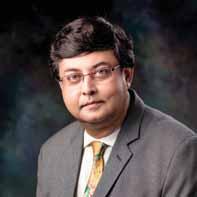
His father S K Mukherjee who was president of RC Ballygunge, got him to join Rotaract in 1981 and later on, helped him to become a member of RC Calcutta Lansdowne in 2001. “My Rotary mentor is PDG Angsuman Bandyopadhyay,” he smiles.
Designed by N Krishnamurthy
For the past five years, thanks to the generosity of donors, Rotary Foundation (India) has had adequate funds for disbursement of grant payments from the RF(I)-INR account. Over the last two years, we are delighted to see an increase in grant activity, and we have completely spent the available World Fund as well as depleted funds in the RF(I)-INR account much faster than anticipated.
Rotary clubs and districts in India are strongly encouraged to register themselves or their fully controlled trust/society under the Foreign Contribution Regulation Act (FCRA) to receive foreign funds directly from TRF and also to receive direct contributions from international partners or other foreign sources. Clubs that are not registered under FCRA may experience a delay in grant payments based on INR funds available from the contributions made within India. Consequently, grants will be placed in a queue and paid on a first-come, first-serve basis only, thus delaying the implementation of their projects. Clubs may contact their chartered accountant who will help to register themselves with FCRA. You can also directly browse through the FCRA website https://fcraonline.nic.in/home/ index.aspx.
A useful resource in the form of PowerPoint presentation is available for club members to use when interacting/holding meetings with prospective members or non-members. It provides an overview of Rotary, includes speaker notes, and is editable to include club-specific images or information. The presentation covers
Rotary’s values, history, and the benefits of membership and is available at https://www.rotary.org/myrotary/en/ document/discover-rotary.
TRF offers clubs several opportunities to earn recognition for their support of its grants and programmes. Here is the list of various club banners available to Rotary clubs: 100% Foundation Giving Club; 100% Every Rotarian, Every Year Club; 100% Paul Harris Fellow Club (one-time recognition); Top Three Per Capita in Annual Fund Giving and 100% Paul Harris Society Club.
Visit the Recognition page on Rotary website at https://www.rotary. org/en/donate/recognition.
Rotary leaders can use the Club Foundation Banner Report to determine whether their club will qualify for the annual recognition banners listed above in the current Rotary year.
All individuals or couples whose combined giving has reached $10,000, regardless of the gift designation are being recognised as Major Donor by TRF. This recognition level can be achieved only through personal contributions and not through matching contribution by another individual, club, district or any other entity or recognition points. Major Donors can choose to receive a crystal recognition piece and pin(s) commemorating the gift at each new recognition level. Name recognition is not automatic and engraving instruction for crystals should be reported to RI staff. Major Donors are listed in the Major Donor, Arch Klumph Society and Bequest Society Report.
Recognition items commemorate giving at these levels:
Level 1: $10,000 to $24,999
Level 2: $25,000 to $49,999
Level 3: $50,000 to $99,999
Level 4: $100,000 to $249,999
Tips to help clubs/districts strengthen their social media engagement in 2021
Identify the most suitable platforms for your club/district on social media
Set up a quality check on content: correct facts, grammar-wise, choice of video and pictures
Create a content calendar for social media
Set yearly goals and identify your audience
For consistent outreach appoint one person for posting
Make creatives which are mobile-friendly
Choose your channels wisely and determine the frequency of posting
Identify the best time to post online
Follow social media handles of other NGOs, partners, RI handles, key local associations and development bodies.
Invest in short-term social media campaigns — organic or paid
Align your social media calendar within your overall Public Image plan
You can engage Rotaractors to help you set up your social media team
Track, measure and share your results
Integrate everywhere.














IInside, doing his daily sadhakam in the morning, is his grandfather Mysore Vasudevacharya, one of the elder statesmen of Carnatic music, a composer par excellence. Young Krishnamurti’s jaw drops in shock and delight as the third man in the car introduces the other two visitors as Ravi Shankar and Allah Rakha, already rising stars in the firmament of Hindustani music, fresh from a concert in the city the previous evening. The mouth remains open for the rest of the morning as the sitar and tabla maestros not only show the greatest reverence for the senior artist but sit down before him to play a mellow morning raga after he expresses his regret that he had not tile-roofed in the old architectural style that gives you a clear view, if you stand outside the front door of the backyard, your eyes sweeping past the three or four living areas of the residence — an authentic agraharam dwelling. Two young men, smartly dressed in white kurta pyjamas, each carrying a musical instrument, get down and of reverie. known of their concert.




t is a winter morning in 1946. An Austin A40 stops in front of a typical middle class street house in Mysore, stretch their arms and legs, before heading towards the front door. The young man seated in the front verandah jumps up startled out of his newspaper-reading reverie.
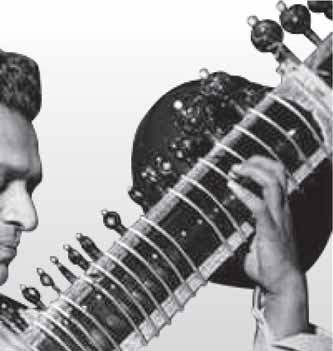
Pandit Ravi Shankar in his younger days.



Because of his vulnerable looks and charisma, he was taken less seriously in his own country as the practitioner of a traditional art than he yearned to be.
The visit to the Vasudevacharya home was no surprise. Pandit Ravi Shankar had much love and respect for things and people south Indian — the ragas, rhythmic sophistication and rigour of Carnatic music, the great artists from Tiger Varadachariar and Veenai Dhanammal to M S Subbulakshmi and T Balasaraswati, even the young musicians he listened to regularly in the last two decades of his life when they performed at San Diego, his adopted California home. True, he was a matinee idol among classical musicians, and perhaps because of his vulnerable

looks and charisma, taken less seriously in his own country as the practitioner of a traditional art than he yearned to be, but he was wedded to his art. Few of India’s music greats had to handle as much adverse criticism as Ravi Shankar had to endure in a lifetime of endeavour to project
the greatness of Indian music to the world. For long accused of diluting Indian classical music to please Western audiences, the maestro was deeply hurt by such charges. Yet there was no denying the purity of the sound produced by his sitar, his brilliance as a composer and creator of ragas,


























his unparalleled eclecticism that took some of the finest ideas and attributes of south Indian classical music to its north Indian counterpart.
Born in Varanasi on April 7, 1920 as the youngest of four brothers, Ravindra, named after Nobel laureate Tagore, hailed from a privileged background. His father, a bar-at-law, and a minister in princely states, was an amateur singer at local soirees, and there was plenty of music and dance in the family. Elder brother Uday Shankar was to become a world
Listeners found my music meditative and blissful. Maybe an artist has to go through hell to create heaven for others.
Pandit Ravi Shankar
famous dancer, taking his troupe, including his siblings, all over the West. Another brother Rajendra was involved in theatre, and stored his drama troupe’s musical instruments at home. Ravi would play those in secrecy.
Young Ravi survived the trauma of his father abandoning his family, and his mother raising her sons on slender means — to experience happier times when brother Uday Shankar became a sensation in the West with his Indian dance troupe. Going at age nine to Paris, where he saw “too much, too soon,” and amidst hectic performance tours and revels with the glitterati, Ravi became an acclaimed dancer in his brother’s Indian ballets. He was still shy at twenty when he turned his back on stardom to answer the call of the sitar, going from a life of comfort to rural Maihar and gruelling lessons from the great Baba Alauddin
At a concert accompanied by his daughter Anoushka.
Khan. He did riyaz for 14 hours a day! Hindustani vocalist Lakshmi Shankar, Ravi’s brother Rajendra’s wife — taught and mentored in music by Ravi when illness forced her to quit Bharatanatyam — once said, “I’ve seen blood coming out of his fingers.”
Ravi Shankar explained the reason behind his drastic step.
“When I was a child, my mother called me chanchal, restless, my guru called me a butterfly. I’ve tried to harness that restlessness in my search for the highest experience of shanta. Listeners found my music meditative, blissful, even healing. Maybe an artist has to go through hell to create heaven for others.”
Ravi Shankar married Annapurna Devi, Allauddin Khan’s daughter and gifted exponent of the surbahar, a string instrument akin to the sitar. Surrounded by murmurs
I was terrified to play with Ravi. I felt I was in no way worthy.
Yehudi Menuhin renowned classical violinist
about Ravi Shankar’s alleged resentment of his wife’s superior talent, the marriage did not last very long. Annapurna Devi retired from concert music and led the life of a recluse until her death in October 2018.
When he went West again as a sitarist in the 1950s, the audiences were small and unappreciative of Indian music. He gave it to them initially in small doses, educating them step by small step. Through countless lecdems at university campuses, he won them over with his natural charm and articulation. He put Indian music on the world map with his own concerts as well as collaborative efforts with some of the leading lights of Western music. Friend and collaborator Yehudi Menuhin, the renowned classical violinist confessed, “I was terrified to play with Ravi. I felt I was in no way worthy.” The likes of flautist Jean Paul Ramphal, conductor Andre Previn and composer Philip Glass felt they were privileged to work on original music the maestro composed. Beatle George Harrison took sitar lessons from him, made albums and toured with him, and edited and introduced his autobiography.
The maestro approached his mission of propagating Indian classical music with utmost
seriousness. An episode during a 1950s tour of Brazil illustrates this. Returning to their hotel from a concert, his troupe, which included tabla wizard Allah Rakha, were confronted by a power outage. They had to climb the stairs to their 14th floor room carrying sitar, tanpura, tabla and other paraphernalia. Ravi Shankar walked briskly up with the others trudging along far behind, moaning and groaning. On the tenth floor, a couple of them sat down, unable
to walk any further. Ravi Shankar made three or four trips up and down from then on, carrying the whole load solo, and finally ferried his exhausted colleagues to their room! He said to them, “Don’t you realise what a great thing we’ve done? We are in Rio de Janeiro, exhibiting our music to the Brazilians and making them love it. It’s no small feat. All our troubles are minor. We’re taking our music to every nook and corner of the world, and that’s all that matters.”
A stout defender of Ravi Shankar’s classicism, Lakshmi Shankar once said, “His Beenkar gharana came from the dhrupad style. It is not light, contrary


Pandit Ravi Shankar and his wife Sukanya.
























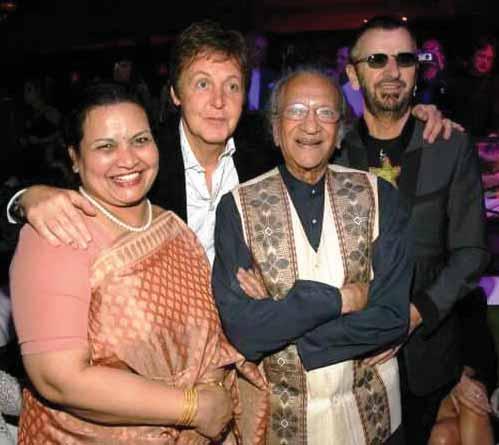
His iconic gurukula ‘Hemangana’, built in Varanasi in 1973–74, housed RIMPA, the Ravi Shankar Institute of Music and Performing Arts. There, 20 to 25 students from all over India annually learnt from Ravi Shankar who taught them through many media — including games he devised for their evening entertainment. In the morning, he was a hard taskmaster, a perfectionist. “Is this the man who laughed and joked with us last night?” the students would wonder. At an annual festival at Hemangana, eminent musicians and dancers performed, with Ravi Shankar’s concert providing the finale.
to all the criticism levelled against his music. Even when he plays a thumri or a gat, he is strictly classical. He admitted making some format changes to attract Western audiences to our music. If he had not done that, it could have meant curtains for our music in the West.”
Over decades of tireless travel and varied performances, Ravi Shankar became one of India’s most celebrated musicians. Awarded the Bharat Ratna in 1999, he received some 15 honorary doctorates, the Ramon Magsayasay Award, two Grammys, the Crystal Award from Davos, the Fukuoka Grand Prize Award from Japan, and countless other awards and honours. He played his music to a great variety of audiences, from the knowledgeable audiences of Varanasi and Pune, to wildly cheering young fans at the Woodstock and Monterey Pop music festivals. He orchestrated
Beatle George Harrison took sitar lessons from Ravi Shankar, made albums and toured with him, and edited and introduced his autobiography.
Indian music for All India Radio, composed music for Indian and international ballets and films including Satyajit Ray’s Pather Panchali, Godaan, Anuradha, Gulzar’s Meera and Richard Attenborough’s Gandhi, and with Ali Akbar Khan, kickstarted a whole new variety of Indian classical music — the jugalbandi.
He was a devoted guru who nurtured young musicians with loving care no matter where they came from. Daughter Anoushka from his second marriage was only one of them, though he was sometimes accused of promoting her.
The atmosphere of Hemangana was fabulous with its aesthetically designed arches, student quarters, and its beautiful orchards. “I’ve never experienced anything so Indian,” a visiting Satyajit Ray once said. Hemangana could not however be sustained beyond three years, because the restless spirit that he was, Ravi Shankar had to move on.
When he passed away at age 92, there had been unresolved questions over his father’s mysterious death, early sexual abuse, his troubled relationship with son Shubhendra who died young, but Ravi Shankar had come to terms with the ebb and flow of his long and dramatic journey on earth. With the strong support of his wife and anchor Sukanya and the joy that spotting young talent had brought him through his many group productions in the twilight of his life, he had achieved peace. The writer is an author and former editor of Sruti magazine.
Designed by Krishnapratheesh
What happens when a team of orthopaedic surgeons and physiotherapists get together? A slew of corrective surgeries that will put little children back on their feet giving them a better quality of life. This was made possible by surgeons Abdul Salaam and Karthikeyan, and physiotherapists Sathishkumar, Kartheeswaran and Madhanagopal — all members of a one-year-old club, RC Coimbatore Meridian, RID 3201 — coming together.
“Basically we are from various other Rotary clubs having come together to form this club and often we used to sponsor corrective surgeries on request from various people. So when we formed this club last March
we were sure of our focus area,” says Dr Sathishkumar, club president.
The club is working on a global grant project with RC Colombo Greater, RID 3220, Sri Lanka, and TRF to enable physically-challenged children walk following surgery and physiotherapy. The club had applied for a global grant last year under the leadership of its charter president Thamilselvan and TRF chair Srinivasan for facilitating the corrective surgeries. Now with a GG sanction of $36,000 and the club’s contribution of $10,600, it aims to sponsor surgeries for 75–100 children a year in and around the city.
“Normally hospitalisation, surgery, assistive devices and therapy
would cost `60,000–80,000 which is unaffordable for the underprivileged. But one of our club members Dr Abdul Salaam who owns the One Care Hospitals in Coimbatore has magnanimously volunteered to perform the surgery free for the most needy,” he says. The club will take care of the basic costs and post-operative expenses “which works out to at least `35,000 a surgery.”
The beneficiaries are identified through screening camps organised in various parts of the city with the support of the Differently-abled Welfare Association. Around 70 children have been shortlisted from two camps and 10 surgeries have been performed so far.
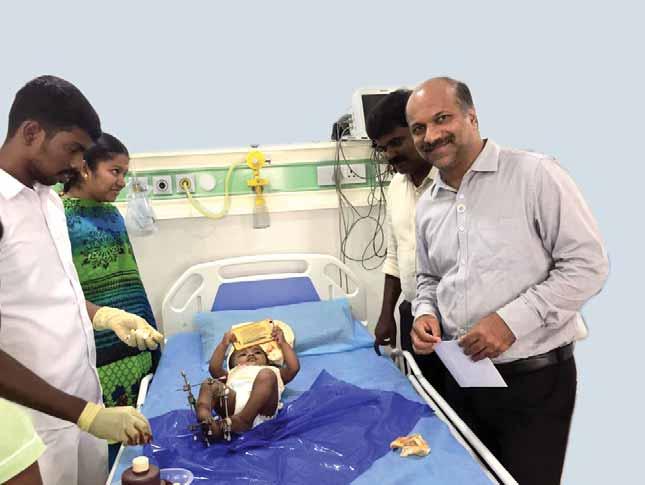
Patients from 1–18 years are treated for deformities such as club foot, bow legs and curved foot. “If corrected at an early age they can walk as normally as possible. Unfortunately most of the villagers are unaware of the corrective treatment, often saying it is the curse of god. Nor do they have the means to undergo such treatment,” he says, adding that mild to moderate physical deformity can be corrected through physiotherapy and with the help of splints but severe deformities call for correction in the soft tissue such as muscles and tendons, and sometimes bones.
Patients from 1 – 1 t r eated f o r de f o rmi t i es cu r c orrected walk as normall y as p o s t unate l y most o f t h e unaware o f t h e correct i of ten say i n g i t is Nor do m eans to treatm e addi n g m o d ica l ca n th r i o t wit h s p lint d e f or m correct s c l es an d somet im



Sandhya Rao
It’s not uncommon for novels to find voice on the big and small screens, but a TV serial becoming a novel? That’s surely unusual.
All these relations originate from these houseboats of ours. Don’t you see how many letters I receive? Letters come from far-off countries across the oceans, where I can never reach. Is there any corner of our own country where we don’t have acquaintances? All this is possible because of these houseboats, which your brothers want to sell.” This passionate and anguished voice belongs to Malla Khaliq, owner of three houseboats on Dal Lake in Srinagar, father of three grown sons and a daughter, belonging to the Hanji community of boating people in Kashmir. For generations his family has lived on water and this is where he sees his children’s future as well. But it is the 1990s and Kashmir is changing. And even though tourism is the bread and butter of this beautiful state’s economy, and houseboats its beating heart, even that is changing. These sentiments expressed by Malla Khaliq synopsise the over 400-page-long novel by Pran

Kishore called Gul, Gulshan, Gulfam, originally written in Kashmiri and translated into English by the wellknown poet, Shafi Shauq. And there hangs a tale that’s screaming to be shared. I had not heard of Shafi Shauq until I met him at the Frankfurt Book Fair in 2006 when India was invited to be the Guest of Honour. I was (and still am) ashamed of my ignorance because his is a very powerful voice in Kashmir’s contemporary literary history. As a poet, fiction writer, linguist and critic, he has written in Kashmiri, English, Urdu and Hindi. I had the opportunity to listen to him reciting his poetry in Frankfurt. One of the pamphlets distributed there carried this poem in English translation:

was accosted by an official-looking stranger who demanded to see his ‘documents’. Intimidated by his demeanour and unfamiliar with local practice, Shauq obliged. In a trice, the stranger made off with his wallet. By the time he could gather his wits and report the incident, Shauq’s bank account in Srinagar had been drained of all funds.

Crossing a street, I lower my head in case of danger. Sometimes, it’s something’s absence I sense — nothing as tangible as rocket or gun. I must be careful. I cross the street, to find the house where I’d expected it to be not there. I look around in case I’m in a new neighbourhood. Easy to lose your way. It’s easy to lose your way at home, to cross the street and never look back. I lower my head instinctively to protect myself from what I can’t see.
One evening, soon after arriving in Frankfurt, Shafi Shauq was taking a walk by the river Main when he

When I saw Shafi Shauq’s name as translator, I went online and discovered something Amit Chaudhuri had written in an Indian Express article dated December 2, 2019, entitled ‘The actual Shafi Shauq’: ‘Among those I met was a small, suited Kashmiri poet called Shafi Shauq. The term “Kashmiri poet” carried a mild voltage. I was speechless for an instant, then said, “Hello!” Not that a Kashmiri poet is an impossibility, but that Shafi Shauq represented a concatenation of impossibilities, to do with his presence here, with a resolution to the problem being found, and peace ever being regained. I wanted to study him closely and ask him for forgiveness. He was diffident, as non-Anglophone writers — especially poets — are. Kafka-like, he’d adopted the guise of normalcy — I mean his 20th-century appearance, the black suit, meant to sidestep attention. He was fair; his eyes shone gently. He had lost hair, like a Jewish intellectual.’ He went on, in the




article, to refer to the very same walletsnatching incident.
This is a digression, but it is a digression that connects; it shows how people are attached to each other in a myriad ways, how even a disconnection is a connection because there cannot be a split without a joining to begin with. I came to this novel late; my mother had read it at least a couple of years earlier, perhaps one of the last novels she read before she died. She had loved it; I could see it in the way her eyes shone when she returned the book to me. ‘Very nice,’ she said, adding that she loved reading about things she had known nothing about. ‘And the people are so real,’ she said. So true, I think as I read. Gul Gulshan Gulfam is that rare book that elaborates on the ordinary lives and relationships of ordinary people engaged simply in the business of eking out a living in the only way they know, in the only place they know. To those outside that milieu, this is exotica, but to the Hanji people, this is life, another ‘India’ even if ‘India’ itself is ‘other’ for them.

The extraordinary thing is that this novel was born as a television serial telecast on Doordarshan. In recent times, there have been occasions when films, particularly for children, have been written up as novels. But Gul Gulshan Gulfam is something else, it’s so big that it’s worth recounting


the details from something that Pran Kishore himself wrote in an article appended to the book (and published online). The article is titled ‘The Dal formed an indelible imprint on my mind…’ Kishore was a well-known name in theatre circles but he nursed a desire to write a novel because he felt books had a greater impact. His first novel, Sheen Ta Vatapod, published in 1987, had received the Sahitya Akademi Award. He was all ready to write his second.
For this he recalled a time in the 1940s when he ‘rented a small boat at the rate of one rupee per day from the quay of my native place, Chinkral Mohalla, in the city of Srinagar. Taking my childhood friends along, I roved through the Maer Canal of the old city and reached Gagribal in the Dal Lake. It was during this journey that the Dal formed an indelible imprint on my mind and I took an interest in the dwellers of the Dal.’
A few years on, Pran Kishore had the happy fortune of meeting Haji Abdul Samad Kotroo who owned a chain of houseboats in the Dal. As Kishore writes, ‘My interactions with this exceptional human being and his family members inspired me to write about the lives of the boatmen of the lake who have been mingling the sweat of their toil with the waters of the lake for generations. Being a father figure, Kotroo Sahib was venerated by not only the boatmen but also the vegetable growers who dwelt in the marshes around the lake. He had continued the tradition that his father had set — of treating the tourists who would often come to escape the maddening city life to stay in his houseboat, as his own kith. Similarly, Malla Khaliq is conscientious of his duties of making his guests feel at home. This is how the seed of the novel Gul Gulshan Gulfam was sown in my mind…’
Whichever Kashmir comes to your mind, the Kashmir of Hindi films, honeymoons and photo ops, or the Kashmir of terrorism, militancy and separatism, it is nowhere near the whole story. Pran Kishore’s book gives readers a chance to peep into that inner world in which flesh and blood people lead strenuous lives enmeshed in a web of relationships and events in a region of incredible beauty that has been under tremendous political, social and economic pressure for uncountable numbers of years. He gets as close to the life breath of Kashmiris as he possibly can, eschewing along the way the many stereotypes and misconceptions, preconceived notions and historical aberrations that have come our way over the years.




But our story for this column is not yet done because here, now, filmmakers Sunil Mehta and Prem Kishen make their entry. In Kashmir to shoot their film Nai Shirvaani based on a Russian short story called ‘The Overcoat’, they heard Pran Kishore narrate to them the story of Gul Gulshan Gulfam, and promptly purchased its broadcasting rights. Before long, the serial was out and airing, its title song echoing in every Hindi-speaking home, with Parikshit Sahni heading a wonderful team of actors and Ved Rahi directing. Muskurati subha ki aur gungunati shaam ki, yeh kahani Gul ki hai, Gulshan ki hai, Gulfam ki apparently went on to win the Best Title Song Award from the Radio, Television Producers’ and Advertisers’ Association!
Shafi Shauq calls the novel the ‘quintessential mahaakaaviya (prose epic) of contemporary Kashmir. In following the lives of characters belonging to three successive generations of post-Independence Kashmir, and paying proportionate attention to the actions and moral


choices of each individual living under specific and sometimes limiting socio-economic and cultural conditions, Gul Gulshan Gulfam emerges as a novel at the cusp of Indian economic liberalisation and Kashmiri identity in flux.’
It’s a tremendously visual narrative, and we now understand why. There are no chapters in the book, only a tiny ink sketch of a shikara or boat, indicating pauses in the telling, thus reflecting the episodic nature of serials. You see how the weather impacts the tourist season, and how tourism is a mainstay. You see competition, exploitation, the pull of traditional practices and nuances of relationships. You see the Khalistan trouble in neighbouring Punjab reducing footfalls into Kashmir. When Khaliq’s eldest grandson returns home from studying medicine in Jaipur, his decision to practice ‘on land’ as against on the


lake, deals a body blow to his grandfather. ‘Nisar Ahmed is going to leave this house today and live on land,’ he cries to his childhood friend, Narayan Joo. When the latter urges him to understand that times have changed, Khaliq says, ‘It is easy to lecture. But only the suffering person knows his pangs.’ And there’s suffering in large doses, as also happy events such as births and marriages. There are wonderful descriptions of Srinagar: the majestic Zabarwan mountains rising above the Dal lake, the different parts of the lake each with its own character, the network of houseboats and shikaras, the waterways, the Jhelum, the Mughal Gardens…

The words ‘If there be paradise (heaven) on earth, it is this, it is this, it is this’ generally ascribed to Hazrat Amir Khusrau are widely believed to describe Kashmir when in fact, they’re

a comment on Delhi. Hard to believe, but this is what Rana Safvi tells us in her book Shahjahanabad: The Living City of Old Delhi. These words are inscribed in the Diwan-i-Khas at Red Fort: Agar Firdaus bar ru-ye zamin ast / Hamin ast-o hamin ast-o hamin ast Yet, despite the heavy militarisation, there is little doubt that the beauty of the land and the people of this much maligned region will meet the expectations of this couplet. In the final analysis, that’s exactly what Gul Gulshan Gulfam does, despite the somewhat shoddy editing. For those more interested in the TV serial, do take a look at Rayan Naqash’s article, ‘Why tourists still look for ‘Gul Gulshan Gulfam’ when they visit the Dal lake in Srinagar’ in scroll.in. You must have guessed by now: these are the names of Malla Khaliq’s three houseboats.
The columnist is a children’s writer and senior journalist.
Designed by Krishnapratheesh

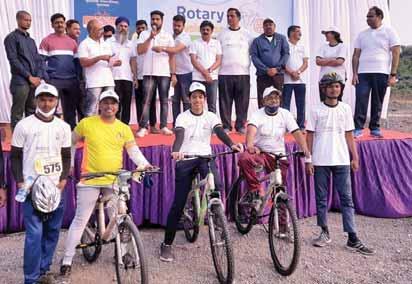
RC Bhusawal Railcity, RID 3030, joined hands with the municipal council of Bhusawal to organise a cyclothon to promote and create awareness on cleanliness under the theme, ‘Green Bhusawal, pollution-free Bhusawal’.
Three rallies of 5, 10 and 20km were flagged off simultaneously. The event had 600 participants aged 4–70. They received a bag of goodies each which included a T-shirt, cap, mask, pen, diary, writing pad, keychain and a few other souvenirs.
At the end of the event, the rallyists gathered together to take an oath to keep Bhusawal clean and green.
Jaishree
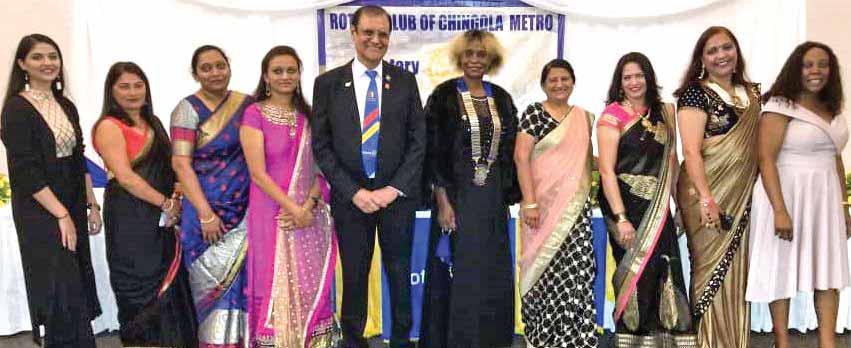
PDG
Have you ever come across an Indian Rotary club sponsoring a club in a foreign country? Rotary Club of Aadarsh Ahmedabad, RID 3054, Gujarat, just did that by chartering RC Chingola Metro in Zambia, RID 9210.
“It all started when I was coordinating with PDG Ravi Devalia of RID 9210 for a medical mission in Zambia a few years back,” says Kapil Bhavsar, trainer for RC Aadarsh Ahmedabad. Subsequently he met Devalia in May 2019 while visiting his niece Chetna Avadekar in Chingola, a city in Zambia
known for copper mining. Bhavsar was distressed to see the poor medical conditions prevailing there and floated an idea to his niece to put up a multi-specialty hospital to help the people, as well as start a Rotary club, promising all help from his own club. “She immediately got into the act.”
Devalia introduced Chetna to Musa Kasonka, a past president of RC Lusaka Maluba, RID 9210, and in July 2020 they went on a membership drive, says Bhavsar. Kasonka became the charter president and Chetna, the club secretary. In three weeks, they got 53
new members at the time of installation, “making it the fourth largest club in the district,” he says. RC Aadarsh Ahmedabad chartered the new club in October 2020. The momentum continued and the club now has 62 members — the third largest after RC Lilongwe with its 67 Rotarians.
Devalia is now working on membership retention. He is supporting the club in various ways to keep the members engaged and their interest in Rotary alive. The two clubs are planning to implement some joint service projects. Providing toilets in and around Chingola is a
priority and Bhavsar has identified a manufacturer who has agreed to give pre-fabricated toilets for `19,000 each against the original cost of `26,000. “My club is coordinating with the African club to send the toilets. We will soon work out a plan to establish the hospital too,” he says.
DG Lucie Kasanga, RID 9210, is very happy with the club’s development. Bhavsar says: “When a community gains a Rotary club, it also gains a heart, and a group of caring men and women who come together to transform the area into a better place.”

RCBurhanpur, RID 3040, helped 12 underprivileged women procure sewing machines on instalment basis with the aim to make them financially strong and self-sufficient. To get a machine under this project,
the beneficiary had to make an initial payment of `1,250 and the balance would be collected as `370 a month. “Only if they pay for their machines the women will have a sense of ownership and dignity. Some of our club
members pitched in for those who were not able to pay the initial instalment,” said club president Rizwan Abbas, adding that the club had also provided 10 sewing machines last month.
An online CSR conclave on water, sanitation and hygiene was hosted by EMGA Suresh Hari, and his team to provide an opportunity for Rotarians to interact with the RISAO staff and non-Rotary professionals. Trustee Gulam Vahanvaty gave the inaugural address on ‘TRF Connect’ and this was followed by a series of
presentations by company officials including E R Ashok Kumar, president, Give India; Debraj S Roy, regional CSR head, Sony India; and Deepak Prabhu Matti, global head, employee volunteering programme, Cognizant.
PDG Ramesh Aggarwal, member, Area of Focus-Gift Initiative, TRF, crisply
presented how Rotary is making a difference in the community through WASH. Rtn Pankaj Patel highligted Rotary’s partnership with Tata Technologies for a mega water harvesting project. “It was a successful global grant project achieved through meticulous planning and involvement of clubs in the zone,” he said.
Ravishankar Dakoju, past president, Rotary Bangalore Orchards, who has given the largest individual pledge to TRF till date gave a prerecorded video talk on why Rotary was his choice of giving. EMGA J B Kamdar, RRFCs John Daniel and Lakkaraju Satyanarain partnered with Hari to make it a successful webinar.
Bharat and Shalan Savur
When you see Madhukar Talwalkar’s strapping, athletic physique and hear his strong, clear voice declare, ‘I’ve just completed 87 years of a wonderful life,’ you are absolutely floored. Then you watch him do calisthenics effortlessly and… you’re speechless. He is the founder of the popular gym Talwalkars. This renowned physical culturist walks his talk!
Never too old. “To change oneself is never too early and you’re never too old,” he says. “Please take care today. If you’re young, start today, you’re fortunate. If you are elderly, you’re still fortunate, start today. If you’re old, you’re still more fortunate, you’re wiser, start today,” he urges. “Just give years to fitness.” He exclaims, “what a disgrace it is for a man to grow old without ever seeing the beauty and strength his body is capable of! Today, I’m in the best of health. My body has never complained about anything, my knees have never troubled me, my lower back has never troubled me. My heart is at its best. I’m a man of abundance!”
He signs off with an inspirational and spirited, “Love your body! Take care of every centimetre of your body! Take care of your health, exercise,
food, sleep and your mind…Then nothing can trouble you.”
Fifty going on 25! For sure, these are exciting times. Things are changing faster than our pulse rate can cope. But don’t let that daunt you. As the gritty ditty goes:
Don’t let anyone steal your spirit, Let it soar and fly on high.
Don’t let anyone slow your progress As you stretch and touch the sky. Dr Amir Hadanny from Israel’s Medical Centre tells us that while lifestyle improvements and exercise do help, the oxygen treatment they are working on is even more effective. Dr Hadanny and Dr Shai Efrati of the Tel Aviv University have found that administering oxygen at high pressure in a chamber for
three months elongates telomeres (when they shorten, we age) in the body and actually makes cells 25 years younger. Put in numbers — a 50-year-old being able to gambol as a 25-year-old — it sounds marvellous, doesn’t it?
Light in dim eyes: Even more heartening is the great promise David Sinclair, professor of genetics at the Harvard Medical School, brings to the health table. Based on his team’s Milestone anti-ageing treatment, Sinclair and his team have restored eyesight in mice. “I’m excited about being able to rejuvenate tissues that fail due to ageing and disease, especially where there are no effective treatments, such as dementia… We hope to treat glaucoma in human patients in two years,” he says.
What a disgrace it is for a man to grow old without ever seeing the beauty and strength his body is capable of!

What exactly did they do? To cut a long story short, they injected OSK — a mix of three “youth-storing” proteins — into the retinal ganglion cells of mice which had optic nerve deterioration and the nerves re-grew “back towards the brain”: old cells transformed into young lively cells and dimmed eyes saw the light brightening their world.
Andrew Huberman is not involved directly with Sinclair’s research but has been observing it keenly. A neuroscientist at the Stanford University School of Medicine, he writes in Nature, “For decades it was argued that understanding normal neural developmental processes would one day lead to the tools to repair the aged or damaged brain… (this) work makes it clear: that era has now arrived.”
It takes me back to another era… when I found myself in a world I’d never seen before — a world blanketed in the silence of the snow in the valley of Kashmir. I disappeared into its white, vast land and when I returned to my senses, the silence inside stayed

and… it sang! And it took my breath away. Youth and health are elixirs of the spirit, surging with the promise and power of unknown forces. Now, 50 years later, I feel that same sense of spirited hope, of a night cracking its shell and day breaking its gold over our horizon.
In his book The power of your mind, Dr Joseph Murphy writes about a gentleman coming up to him after his talk and saying, ‘I am 84 years of age. I operate every morning, visit patients in the afternoon, and I write for medical and other scientific journals in the evening.’ Dr Murphy observes, “His attitude was that he was as useful as he believed himself to be and as young as his thoughts. He said to me, ‘A person is as strong as he thinks he is, and as valuable as he thinks he is. If I should pass on tomorrow, I will find myself helping and curing people in the next dimension, not with a surgeon’s scalpel, but with mental and spiritual surgery.’ And Dr Murphy concludes, “This surgeon has not surrendered to advancing years. He knows that he is immortal.”
Breath of immortality: Are we already on the threshold of the next dimension the surgeon is talking about? Is the next dimension right here on earth? Are we not going to die? For genetic engineer Jose Luis Cordeiro and mathematician at the Cambridge University David Wood have written The Death of Death, their scientific take on immortality. They expect ageing to be reversed and death to be optional by 2045. “Humans will only die in accidents, never of natural causes or illness,” they say.
With nanotechnology, they hope to “print” in 3D the required body organs. It won’t be just about transplanting new organs, but also replacing unhealthy genes with healthy genes, dead cells with living ones, repairing
Within 10 years, all these anti-ageing, anti-dying treatments to cost as much as the latest smartphone!
damaged cells, using stem cells and so on. Within 10 years, cancer will be curable and so will other diseases, they state. And if we wonder if all this will be terrifically expensive, designed only for the super rich, Cordeiro and Wood have an answer even to that. Initially, it would be expensive, but with a competitive market, the price would gradually decrease because the demand would increase and benefit everyone. The two engineers expect all these anti-ageing, anti-dying treatments to cost as much as the latest smartphone! The fact is: all kinds of buttons are being pushed in our smartminds as science rolls out earth-shaking cures and solutions, even immortality. Will our finer human sensitivities die in this technological advance or will it be more refined versions of ourselves? And yet, I can’t help but feel that our ancient yogis did find such miraculous cures in the herbs and purified air of the Himalayas. Will our myths of immortality dance with the truths of tomorrow? Meanwhile, OSK, the youth protein cocktail prances in our laboratories, a disease-free life awaits us around the corner and right in front of our eyes, we see the new becoming the norm. It’s like stepping into a time-tweaked programme. Weird, but wonderful.
The writers are authors of Fitness for Life and Simply Spiritual – You Are Naturally Divine and teachers of the Fitness for Life programme.

A heart and lung screeing camp was held in association with a drug firm. Club president Manoharan coordinated the camp which benefitted over 300 people. ECG, BP, and other tests were done.
Cataract surgeries were done on 62 elderly patients at a mega eye camp organised by the club.
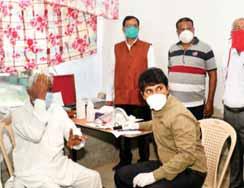

Tree plantation was done at a temple in Veeradipatti village under the leadership of club president A Senthil. Club member V M S Veerappan coordinated the project.
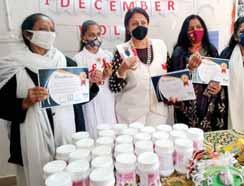
On World AIDS Day, the club distributed protein powder to HIV positive children at the Civil Hospital, Gandhinagar.
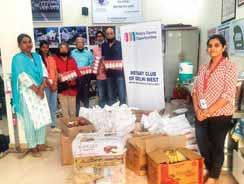
The club distributed medical consumables and fruits worth `2 lakh to Earth Saviours, a home for the abandoned run by Magsaysay Award winner Ravi Kalra.
Ration kits were distributed to needy with support from the Rama Krishna Mission and forest department officials.


A washing machine was donated to a school for the visuallyimpaired girls. The members distributed snacks and juices to the students.
UP Governor Anandi Ben Patel visited the club and interacted with the Rotarians. AG Sidharth Singhal presented her a lapel pin on RI theme. She invited the club members for an evening tea.
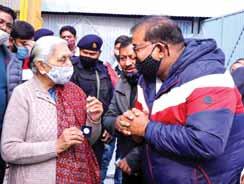

Polio Day was observed with Rotarians giving polio drops to immunise the children.
A stall was set up by the club at the Gandhi Chowk, Kasia, to collect sparingly used warm clothes and distribute the same to needy families in the neighbourhood.

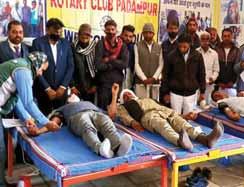
A blood donation camp was held to mark the martyrdom of Capt Navpal Singh and 75 units of blood was collected.
Sub-divisional magistrate Subhash Kumar took part.
Under Project Ek Nishchay (A resolve), the club, in partnership with S G Analytics, donated grocery kits to 8,000 migrant families in four months.
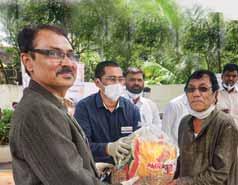
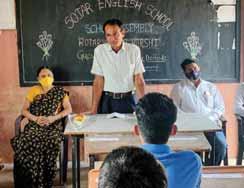
The club conducted assemblies in various schools for students of Classes 9–10. The Rotarians engaged the students on Rotary values and different projects are being planned in these schools.

Daily essentials were distributed to 50 differently-abled people. Governor’s principal aide Sarjerao Sawant was the chief guest at the event.

Essay and drawing competitions were held for high school students on the eve of Global Handwashing Day to create awareness on hygiene. The contest drew good response.
The club joined hands with the Karkala municipality to set up a pipe composting. Club president Rekha Upadhyaya created awareness on converting household waste into organic manure.

Two electric geysers were donated to Nayachethana Trust that takes care of differently-abled persons.
Club president Sandeep Nijagal coordinated the project.


Club president Simon C K donated face masks and juice packs worth `1.5 lakh to the corporation commissioner S K Jatavath.

A digital classroom worth `1.15 lakh was donated to a government school to enhance classroom education.
A passenger waiting room worth `1 lakh was constructed near the Government Paluram Dhanania College for the convenience of residents. Dr Satish Agarwal played a key role in this project.


The club donated tricycles and crutches at the SIHR & LC Hospital, Karigiri, near Katpadi.
A Rotary clock tower with a traffic post costing `10 lakh was built in the heart of the town at Station Square.


A two-day RYLA was organised for 55 Rotaractors at Javadhu hills in which leadership sessions and a forest walk were the major highlights.
A polio awareness car rally was held in the presence of councillor Susmita Bhattacharya, DG Sudip Mukherjee and PDG Ravi Sehgal.

Compiled by V Muthukumaran
Last month a small group of us decided to visit our old college in Delhi University, the academically venerable but very low profile Hindu College. It brought back some wonderful memories. As the name suggests, the college was started in 1899 as a nationalist college. The old college magazines contain a lot of material on the events of the time. The British frowned upon the college. Our little group had joined the college and hostel in July 1967. Most of us were just 16 years old. Imagine, just 16! A few were all of 17. The oldest lot were just 21, finishing their MA degree, but they made up barely 15 per cent of the total. The freshers were ragged by the seniors for a month. Then on Aug 15 they were hosted to a grand dinner by them. Ragging was traumatic in the first week but you got used to it because it was never vicious. My best recollection of it is my having to follow a senior around at all times with an ashtray in my hand so that he could flick his cigarette ash into it. I was not allowed to speak but let off for class. The same senior also once took five freshers to a film. He paid for their tickets and sat in the row immediately behind them — and told them they had to look back at him throughout the film and then tell him the story over dinner. It was, for the most part, harmless fun.
Well, 1967 is 54 years ago and it was nice to see that in that time,
other than some new buildings to accommodate new courses and more students, the college had not changed much. We wondered at the small classrooms that accommodated just 25 students. My class had started with 14 students in the first year and ended with 10 when we graduated three years later. The teaching was very cosy because if the classes were small, the tutorial groups were even smaller, 3–4 strong. Besides, most of the faculty lived on the campus and sometimes the tutorials were held in their drawing room over tea and samosas. It was all very civilised.
When you are 16 and have to live away from home along with 120 other boys, it changes you forever — mainly because you are always hungry. It’s not that the hostel food was insufficient. It was just that we were growing up lads and very active. Pocket money had to be conserved through the month,

which left most of us hungry at all times because there were other things like films to spend on. And of course the new freedom meant we all smoked. A packet of 10 Charminar cigarettes cost 30 paise which meant `9 a month or a fourth of the total pocket money. Hunger was a natural corollary.
The hostel, however, now looks quite decrepit because the college is not allowed to increase fees. We used to have single rooms but now as many as four students are crammed into one room, and this was very sad to see. I hope the hostel is soon rebuilt along the lines of the new, modern girls’ hostel.
The visit brought back some wonderful memories for all of us — disappointments, successes, infatuations, follies, and, above all, friends who matter.
The high point of our lives in college was the sports ground. It is a huge, grassy rectangle of about five acres. It had the cricket pitch in the middle and the tennis courts on the side, which have now gone. Cricket was the focal point and still is. In the late 1960s the college team had four regular Ranji trophy and two Duleep trophy level players. It has produced three or four Test level players also since 1955. I tried to play for the college team but just wasn’t good enough!
Disappointments, successes, infatuations, follies, and, above all, friends who matter more than any of the other things college had to offer, the visit brought back some wonderful memories for all of us.
No one talked much. But the silence was eloquent.





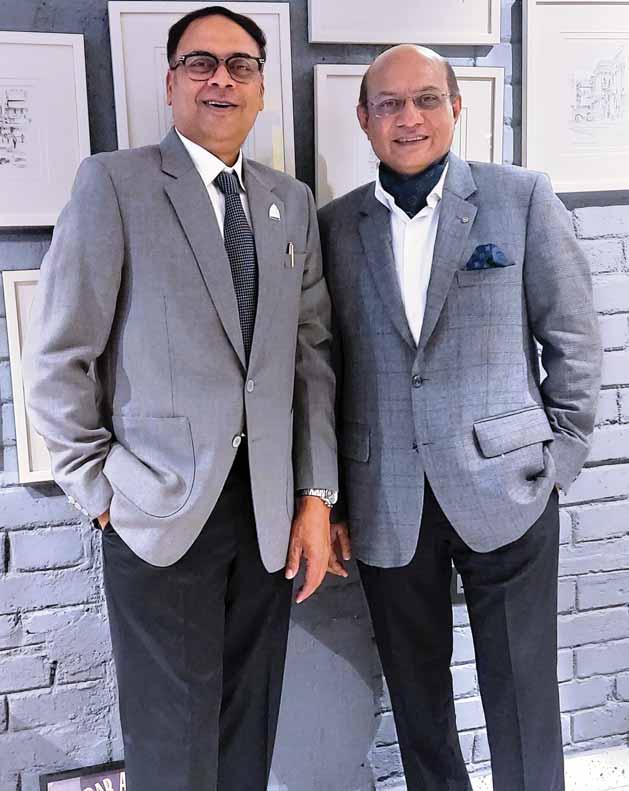


Regn. No. TN/CCN/360/2021-2023
Licensed to post WPP No.TN/PMG(CCR)/WPP 431/21-23
Total number of pages in this monthly issue, including cover, 84. Price: `35
Registered with Registrar of News Papers for India 3880/57 Rotary News Published on the first week of every month

DGEs with RIPE Shekhar Mehta and Rashi, RI Director Bharat Pandya, Madhavi, RI Director Kamal Sanghvi, TRF Trustee Gulam Vahanvaty, RIDE Mahesh Kotbagi, Amita, RIDE A S Ventakesh, Vinita, PRID Manoj Desai, PDG Ranjan Dhingra and PDG T K Ruby.